A Q&A I took part in hosted by my good friend Ellinor Bognar, who works in publishing. It was a joy to talk about what I’d learnt writing a biography on my late father.
For more details on my book you can go to cartapublishing.com
A Q&A I took part in hosted by my good friend Ellinor Bognar, who works in publishing. It was a joy to talk about what I’d learnt writing a biography on my late father.
For more details on my book you can go to cartapublishing.com
Four years ago I announced to the world I was going to write a memoir about my late father. Why? Was the question I was asked (by those who didn’t know my father).
Well, let me begin. My father was a larger-than-life character, who inspired me, and many others, in multiple areas of our lives. When he died, albeit before his time due to a lung cancer caused by exposure to asbestos, I felt an overwhelming sense of gratitude that I had had this man as my father.
Working as I do in the field of organisation development/learning and development, I have long been involved with management and leadership development. I have designed, delivered, commissioned and outsourced many programmes over the years, and continue to do so. I am well familiar with the plethora of management theories, platitudes and gurus that abound. But if you stop and ask me, who was the most influential leader in my life, it was, short and simple, my father, Alan Carter.
With his passing I felt I wanted to capture many of the lessons I had learnt from him. Throughout my life, watching his example, I took silent notes. And these are the tenets I live my life by now. I was at a loss, however, how to capture all these small instances of learning, how to present them to the world, and for whom.
I wrestled with these thoughts until one day, my husband simply said, why don’t you write a biography? My first reaction was, don’t be ridiculous. How could I possibly do that? At the time I was writing blogs and found it no problem at all to rattle off a couple of pages, with a good story as an opener, a few key points of insight and learning, and a conclusion. I had the whole process down pat. But how to capture someone’s whole life – someone who packed as much in as my father? No clue. I literally had no idea how to begin, other than an overwhelming sense that this certainly would be a most fitting legacy to my father, and that I should try.
So I began. I googled ‘how to write a memoir’ and ‘how to write a biography’ and found not much. I wasn’t even sure which I was writing. So I decided not to worry about someone else’s blue-print, and just to start. At the beginning.
The beginning of someone’s life is easy. You can start with their birth and childhood. You can delve into who their parents were and how they helped to form their character. All this I did. What I found though is it is easy to disappear down rabbit holes. I was reading fantastic accounts we have in our family. We have letters and correspondence from my father’s grandparents. These were fascinating, but ultimately, they were a story for another day, and I had to leave these out of the book. So there-in lies my first learning:
Be clear on the story you are trying to tell.
My second learning was around organisation. I had so much information: diaries, letters, blogs, I was drowning. I needed a way to capture what information I had and where it would be useful. I had a few systems I used, spreadsheets, folder systems, and time-lines. These could have been better, but they were good enough.
Start with a system to order your information.
My third learning was around research. I had lots of information, but there were still gaps. How I wished I’d paid more attention when my father had talked about his career over the years for instance! I drew up a list of his friends and ex-colleagues that I wanted to speak to. At the early stages I was hesitant to contact people, seemingly out of the blue, to talk about someone that had died some years before, when their connection may have been decades earlier. I wish I’d bitten the bullet earlier on that one. This one was around self-belief, and me doubting in the fact that there actually would be a book at the end and that people would be happy to contribute. As it turns out, everyone I managed to get hold of was delighted to contribute, and the conversations I had were valuable for the book and meaningful for me in many ways.
Plug your information gaps early.
My fourth learning was from others. Once I’d gone as far as I could with researching and writing, I had the task of organizing my words into some semblance of order, so it worked as a cohesive whole with a narrative, rather than a collection of stories and incidents. I was stuck on how to do this, and at this point reached out to a book coach. All my questions on ‘how should I…’ I could now ask. This got me through the ‘hard’ middle section of the process, ordering what I’d done and creating a structure, which is the biggest challenge when you have a whole life story to cover.
Get expert guidance when you need it
My fifth and most critical learning, however, was around self-belief. The whole process, from start to finish, took four years. There were months in that time where I did nothing to push the project forward, either due to other distractions in life (think pandemic), or because I was stuck, or didn’t have the self-belief to push myself forward. In the end, it took a little (or actually big) miracle to set me straight. Call it what you will, but to me a divine intervention showed me that I HAD to finish the book. Literally from that moment on, I did what I hadn’t been able to do before and focused in on pulling everything together into my first draft. I found I had written plenty, it just needed arranging, a few gaps to fill, and adding in the extra material that came my way, gave me the rounded book I was searching for.
Believing makes all the difference.
So what advice would I give to anyone else wanting to start a similar project?
Believe you can do it.
Rachel’s first book ‘My Father, Alan Carter’ is now in print. You can get a copy here: https://cartapublishing.com/
Lots of people are writing lists of their achievements/highlights of the past year. For me, there is only one, and that is finishing writing my book, a memoir about my late father, Alan Carter.
It’s due out in March on my father’s birthday. You can sign-up for the waitlist here (there’s no obligation – I’ll just send you an email when it’s ready to order).
To be honest, I think I doubted my ability from the outset of how to write it. Writing a memoir is tricky. This is partly due to the amount of research that needs to be undertaken, and then wrestling with it, attempting to craft it into a structure, and most importantly learning to use your own voice. I’ve not studied writing formally beyond an ‘A’ Level in English Literature, and while I enjoy reading good quality writing I hadn’t particularly studied the art form of the memoir. So I learnt as I went along.
I started four years ago, and with various stops and starts I had done lots of work but was struggling to pull it all together. I set myself a goal at the start of this year to finish in 2023. By the summer I was stuck again and ready to give up. That was until, I tried to let go of the project and then something so miraculous happened I had no option but to finish the book. I had some quiet time between work projects and worked flat out, full-time, no longer questioning if I could do this thing, but rather, just doing it.
A few people have asked me what was so special about my father, that I should choose to write a book about his life. Well, the short answer to that is, read the book and you will see!
The longer answer is that he was a larger than life character that inspired many, including me. The book follows his journey as a young teenager in London choosing to join The Church of Jesus Christ of Latter-Day Saints, his love of outdoor adventuring, his natural enthusiasm and zest for life. Spanning three continents and drawing from his own fishing blog, I’ve brought together all his stories. He was someone that always worked hard to improve himself, to serve others, and to fully live his faith. So, if you’re curious, sign-up to the waitlist. And again, there’s absolutely no obligation, just an email I’ll send when it’s ready. But I would love for you to read my book about my father, Alan Carter.
This was our third summer road-trip together, and it felt different. This time we wanted an escape. We planned our venture north, heading to Sweden, unchartered territory for both of us. Valentin’s end of school-year stress had built after a few months stacked up with piles of illegible essays to mark, so we craved open space and an open schedule.
That doesn’t mean to say there weren’t some delights on the way. We timed our travels so that we had an afternoon and evening in Copenhagen. I’d been before, so wasn’t desperate to linger there, and felt we could get the feel of the place in that time. The drive to Copenhagen was fascinating, over bridges that stretched longer and higher than any I’d ever driven across. The bridge was broken up by a couple of islands, the dark sea stretching away either side. The land was bright green, and the coastline populated with colourful houses and green trees. Not like crossing the Severn Bridge between Wales and the UK, where the harsh industrial landscape dominates. The drive through Denmark to this point had been easy. The roads weren’t busy, and the landscape began to roll and undulate more like the British countryside than the flatness of the Netherlands. The golden wheat-fields also reminded me of home, a crop not grown by the Dutch as the soil is too wet.
I was excited to arrive in Copenhagen and feel the familiarity. I’d spent a long weekend there with a group of friends, and we’d traipsed the length and breadth of the city, looking for landmarks such as the Church of Our Lady which is home to the original statue of the Christus and the Twelve Apostles. That time it had taken us many attempts to find it. The church was not a particularly beautiful one from the outside and was a bit further out from the main city attractions. When my friends and I finally found it open, the moment we entered and saw the remarkable statue with its gold surround, a beam of sunlight entered the room from the majestic door, hitting the curved gold backdrop, sending a rainbow of golden light across all that lay in front of the Christus.
Arriving in the city this time, I immediately recognized where we were, and knew exactly which way to go. Weaving our way through the busy crowds, the warm sun shining down, we made our way there and I recounted to Valentin the stories from my last visit. The rainbow was not there this time, but another wonder was. As we walked in the boom and melody of a church organ rang through, vibrating all the pews and lending majesty to the occasion.
We wandered further, out up to the Citadel, the old army barracks surrounded by a pentagon shaped moat with bastioned ramparts. This style of fortification is commonly seen in the Netherlands in old cities like Heusden. Our walk took us up along the waterfront promenade to the Little Mermaid statue. Rather than join the heckling throng attempting to get selfies with the statue in the background, we took in the beauty of the figure, sitting in solitude at the edge between the land and the water, watching and waiting as the warm evening sun began to descend.
The next day, after our fill of the delights of the Danish capital city, we took a short ferry ride into Sweden. Our departure point was Helsingor, a port known for Kronberg Castle, referenced in Shakespeare’s Hamlet. I’d visited the castle before with my friends, enjoying the banter with the actors that wandered the halls, and knew I would rather preserve that memory than risk diluting it, so this time it was a hasty trip round the exterior, whilst the sea-wind whipped our hair.
At first the landscape in Sweden didn’t seem to differ much to Denmark, then gradually the bright green deciduous trees made way for taller, darker fir trees. It was all nature. We drove past wooden houses and chalets, painted the colour of rust. The contours of the land grew deeper, and we finally had a view of dark green forest that extended to the horizon.
Reaching our destination, we found our host was cutting wood with industrial-scale equipment in a wooden garage. He came out, smiling and friendly dressed in his leather safety trousers and checked shirt and ear protectors. He spoke English with a musical lilt, that instantly reminded me of my Swedish best friend, which warmed my heart. He offered to drive us out to our home for the next few days, and we followed him along an undulating track, getting deeper and deeper into the forest and further away from the road and the handful of houses.
Our neighbours for the next few days were his cows, and a flighty pair of pied wagtails. The mother cows and their calves would look suspiciously at us, and even more so when I would greet them and converse as if they could understand me, a human.
The next two days were spent on various walks, and we didn’t see a single other soul whilst following the tracks and paths as we wound through the fir trees. Bright green mossy banks rippled up the hills, the sun striking and creating a dappled effect when it glanced in-between the conifers. This was a landscape with boulders, large rocks lying as if a giant had been playing with marbles and left them, scattered.
A painting I had seen came to me in a dream. Hanging in my Swedish friends’ house, it finally made sense to me. The same vertical fir trees, the moss, the tapestry of greens and browns, and to one side a hunter with a gun, camouflaged, still and silent. Now I understood the painting, being in the same forest, the patchwork of colours in front of me an identical match to the canvas.
My friends’ collection of Swedish trolls came to mind in the same dream. The magical landscape and sense of hidden creatures in the forest conjured up these mini beings with their big eyes and crazy hair. Sweden felt wild, remote, and somewhere that you could just be. I woke up thinking of my friend, and how I finally felt I knew her, after all these years, seeing the place she was from.
The lakes in the forest were wide and still. The water in streams ran with a reddish-brown tinge. Our first walk around a lake and the silent air was pierced by two cranes, stalking the water’s edge, calling out a distress cry as if they had lost their young. They faced opposite directions, and systematically worked their way along the lake-side. As we ventured deeper into the forest, climbing higher and higher on our trail, climbing over the many fallen trees, we could still hear their cry at times when the wind caught the sound.
On our last night, we climbed a nearby hill to watch the sunset from one of the wooden viewing platforms that populated the forest around our cabin. I’d come across this one earlier in the day, when I ventured out on my own following a morning of rain. I’d seen a large rock on a hill from the path I was on and fought my way through dense ferns to reach it. Getting closer I saw the viewing platform offered a better view, and as the skies darkened and thunder rumbled in the distance I stood atop, with the whole magnificent vista in front of me. Grey skies and endless green forest, I had a front-row seat to the looming rumblings and crashings. I excitedly led Valentin the same way that evening. The storm had cleared, and pink hued skies replaced the dark ones. I was hopeful we would finally get a sighting of a deer or moose, as I’d seen evidence of a large animal in the vicinity with some fresh droppings on the ground. We stood silently, drinking in the stillness, wondering what creatures were waking in the dense undergrowth as dusk crept in.
It must have been a long time since I had been in such a vast, unpopulated space. We loved our brief sojourn to Sweden and left sure that we would return.
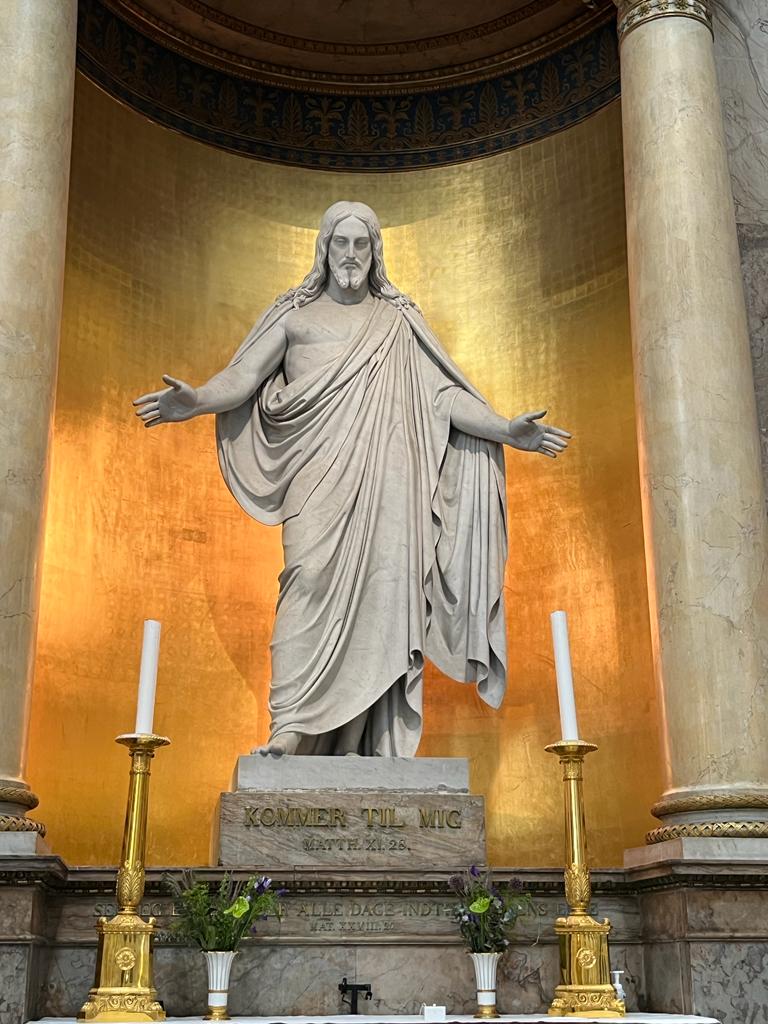
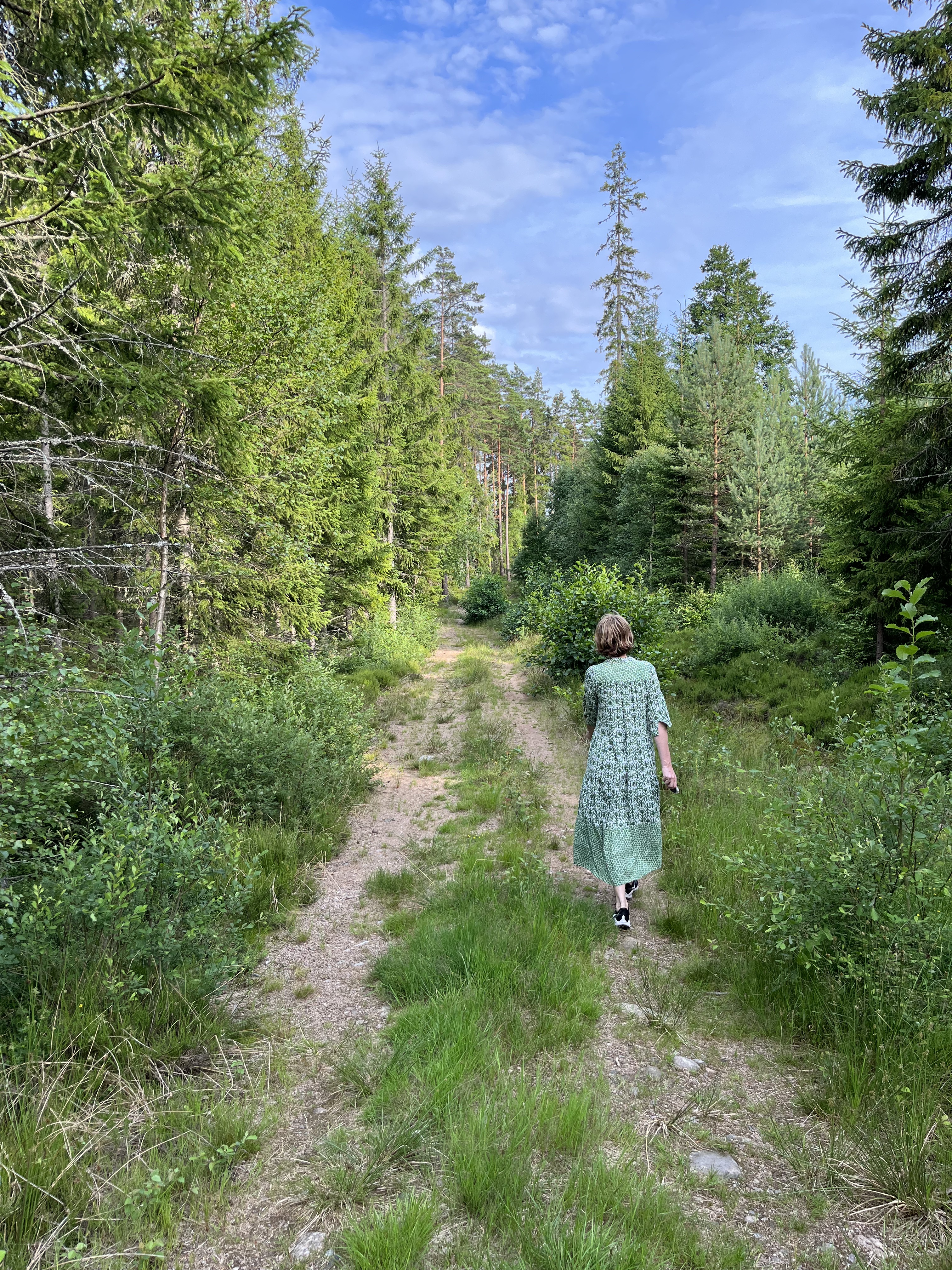
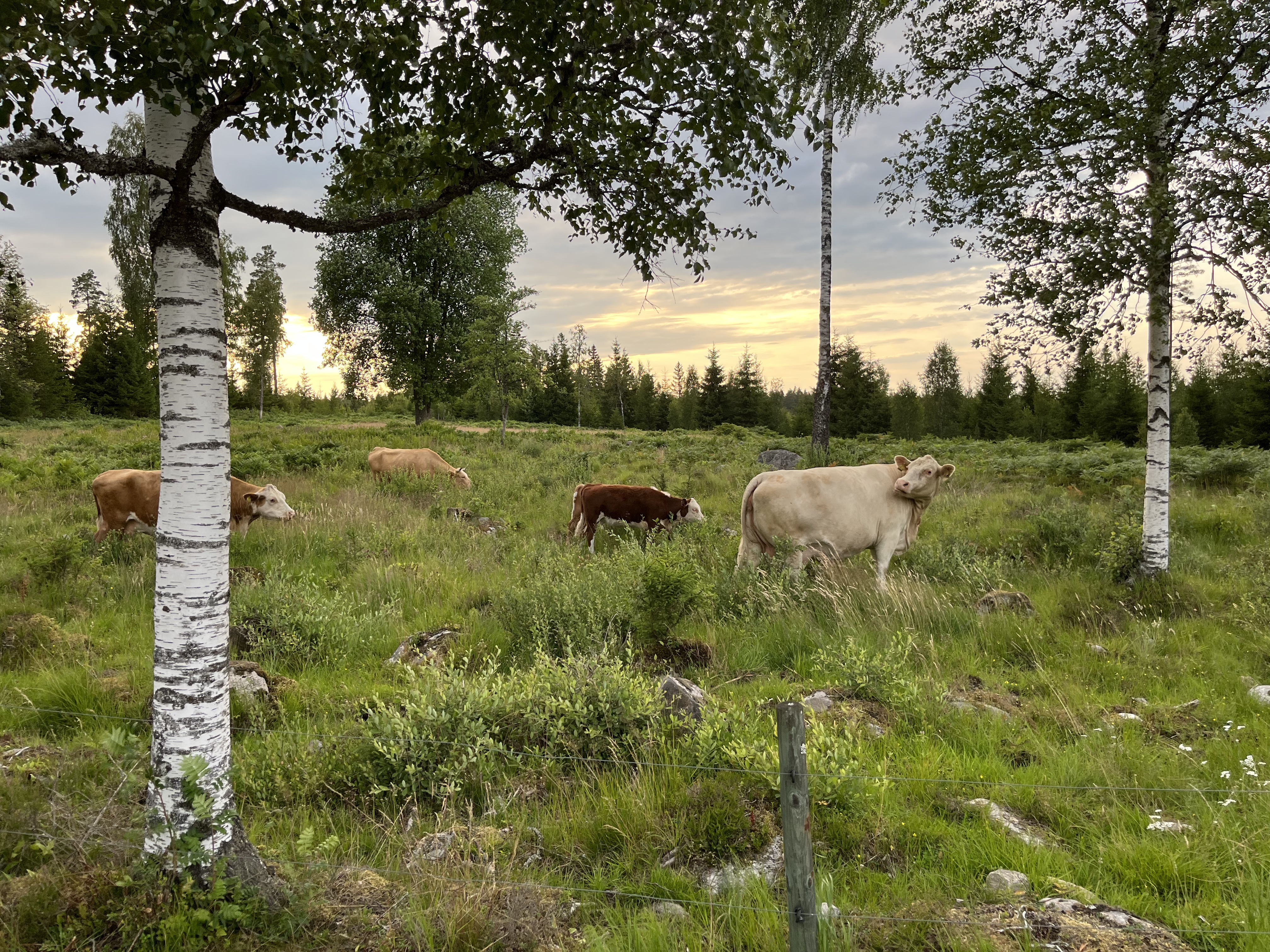
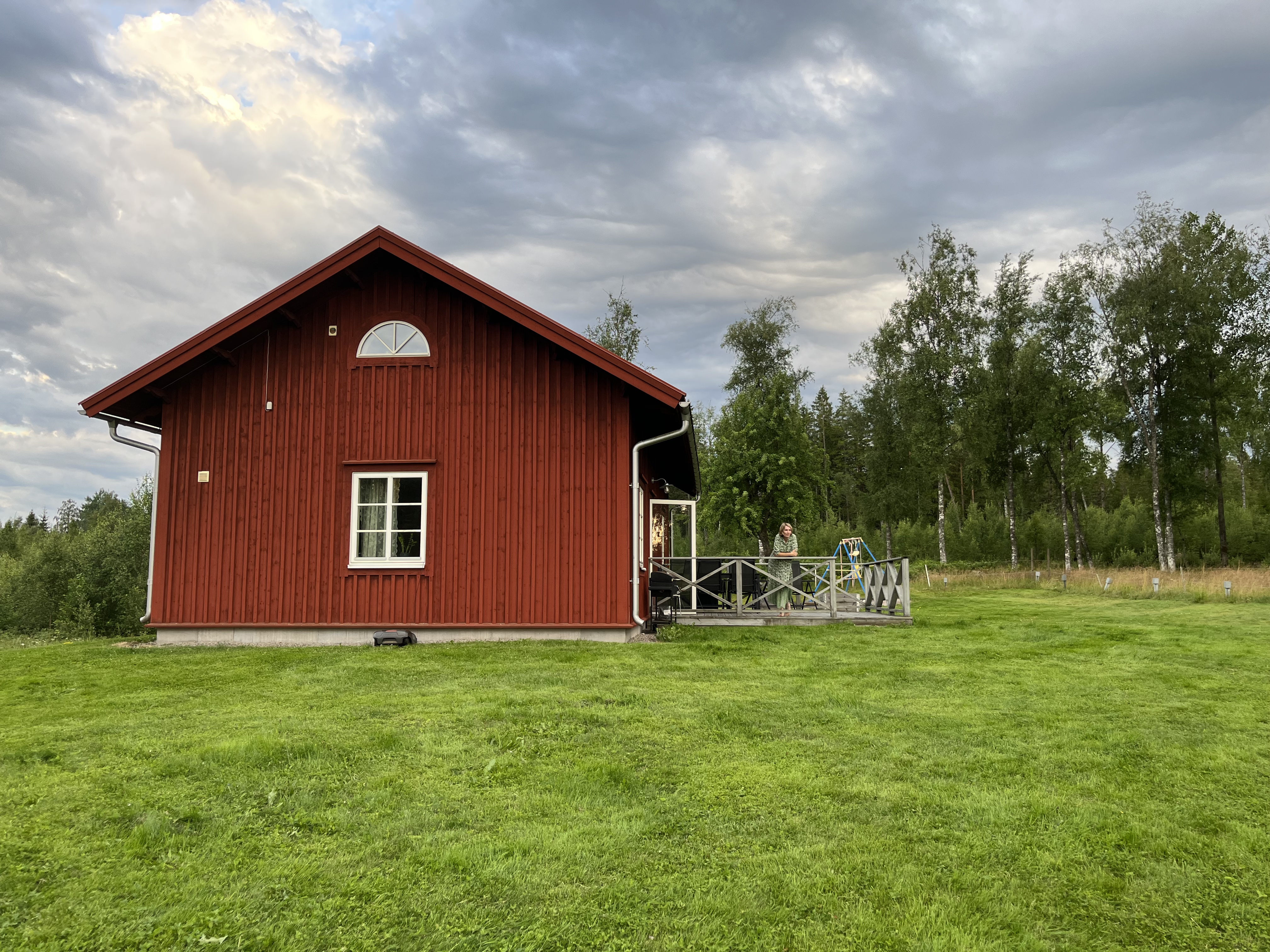
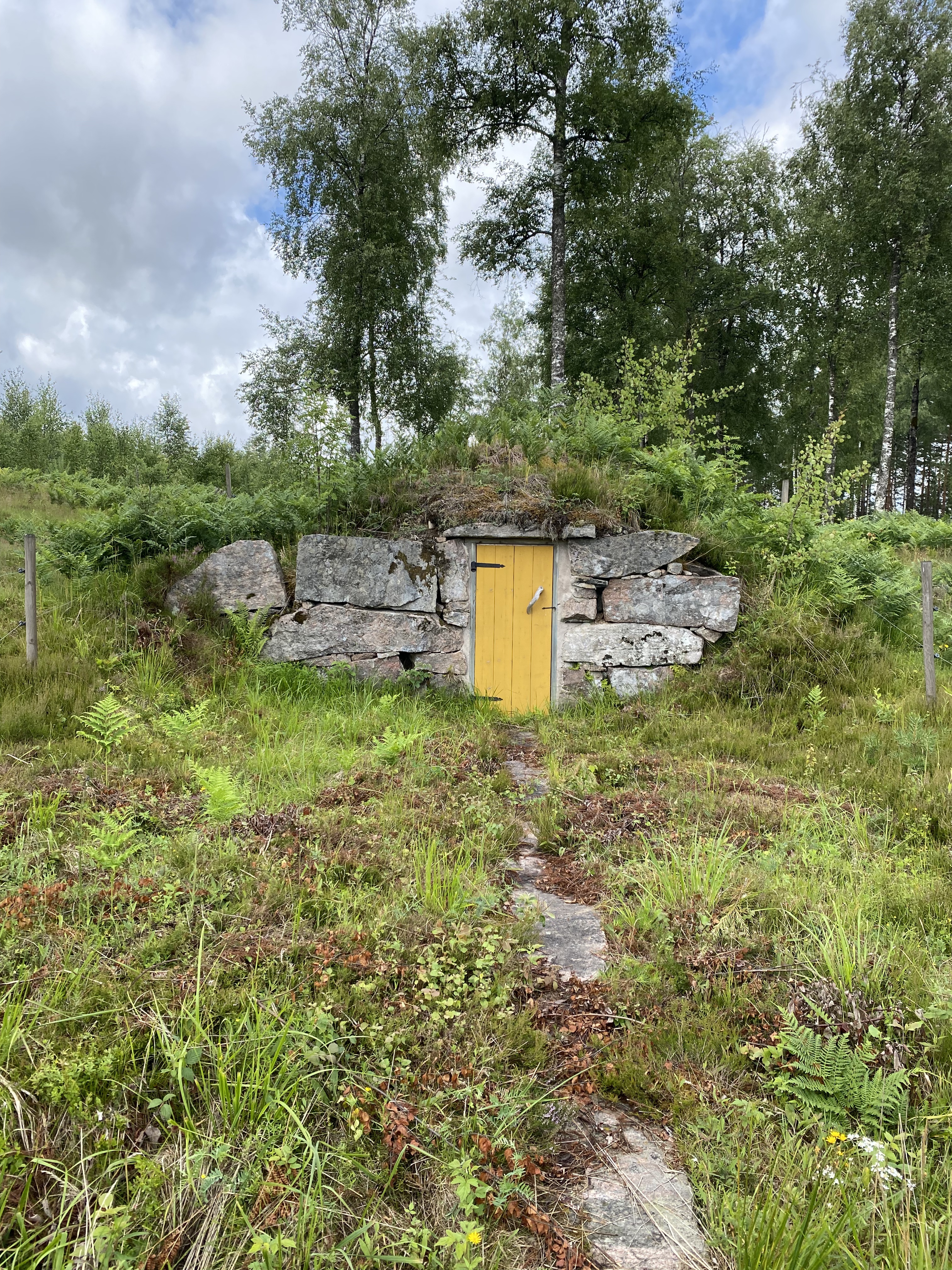
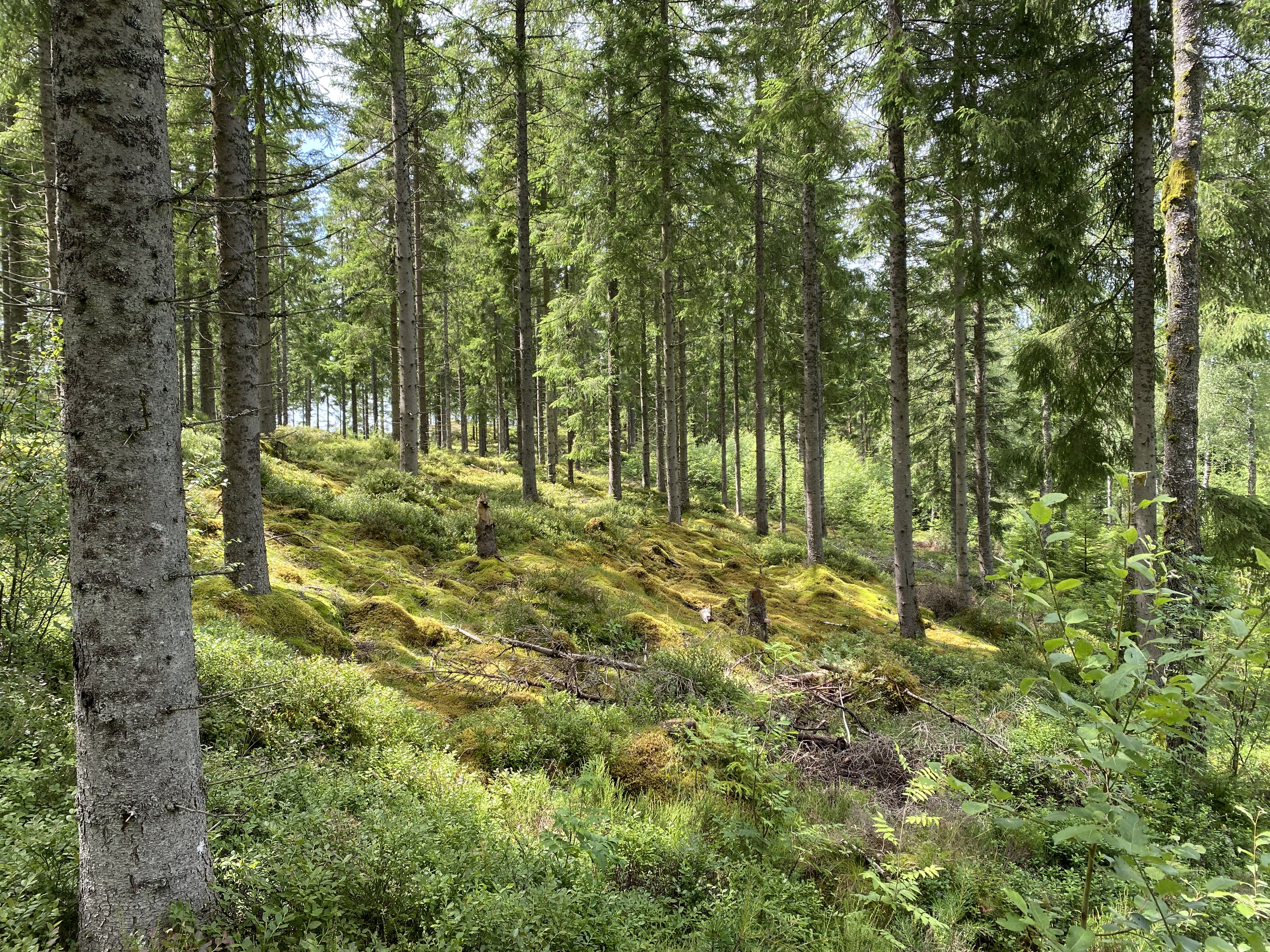
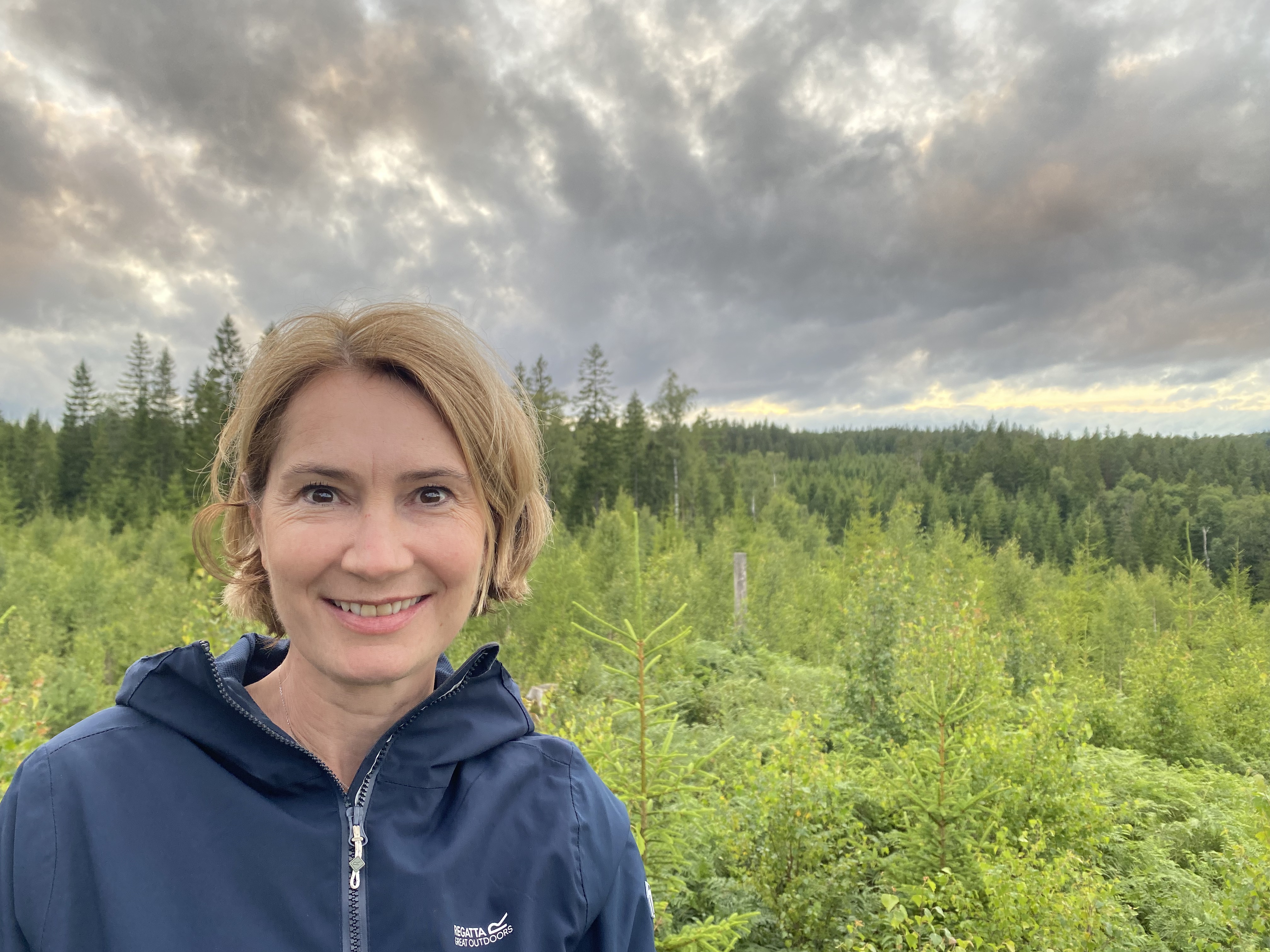
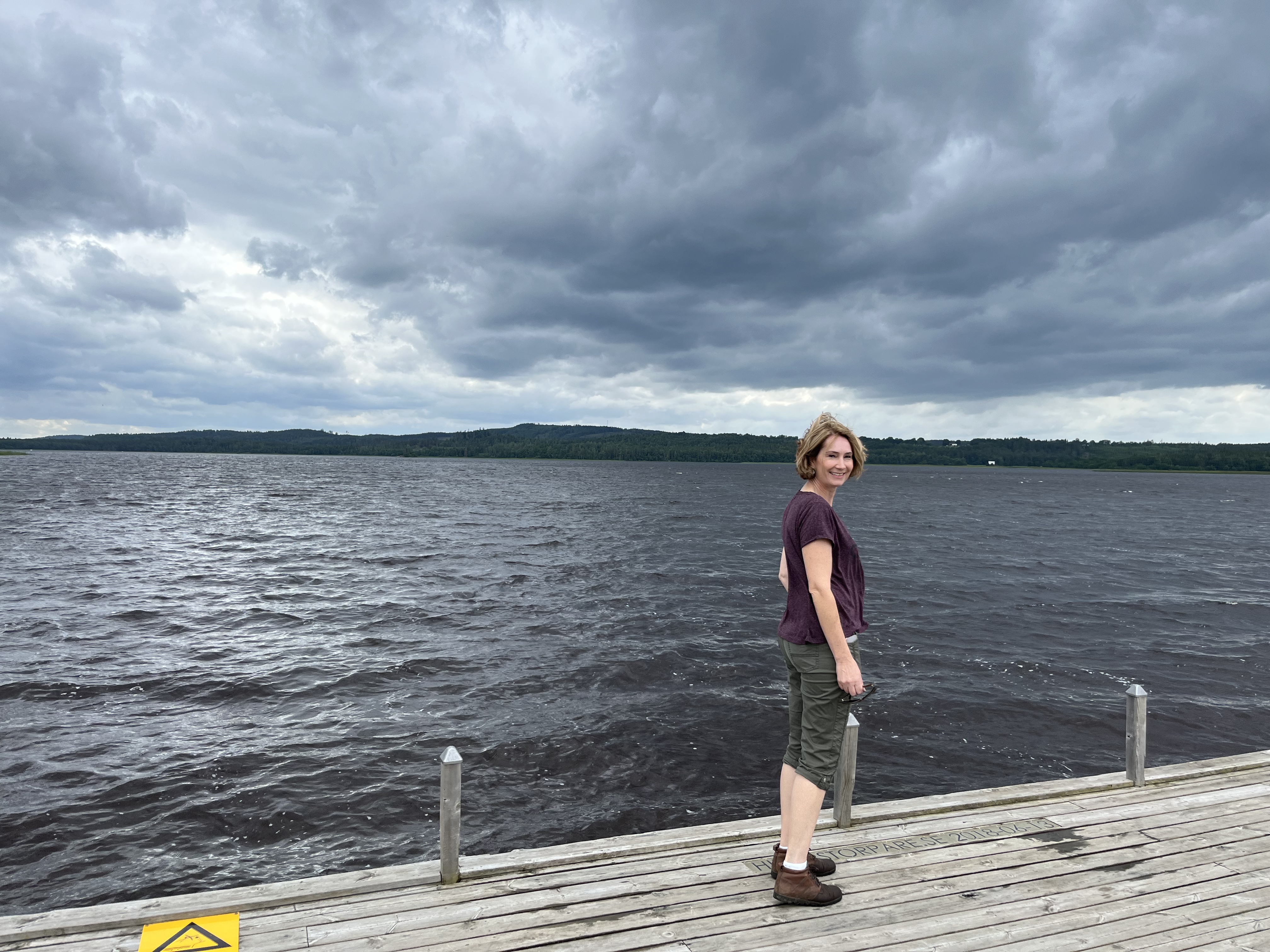
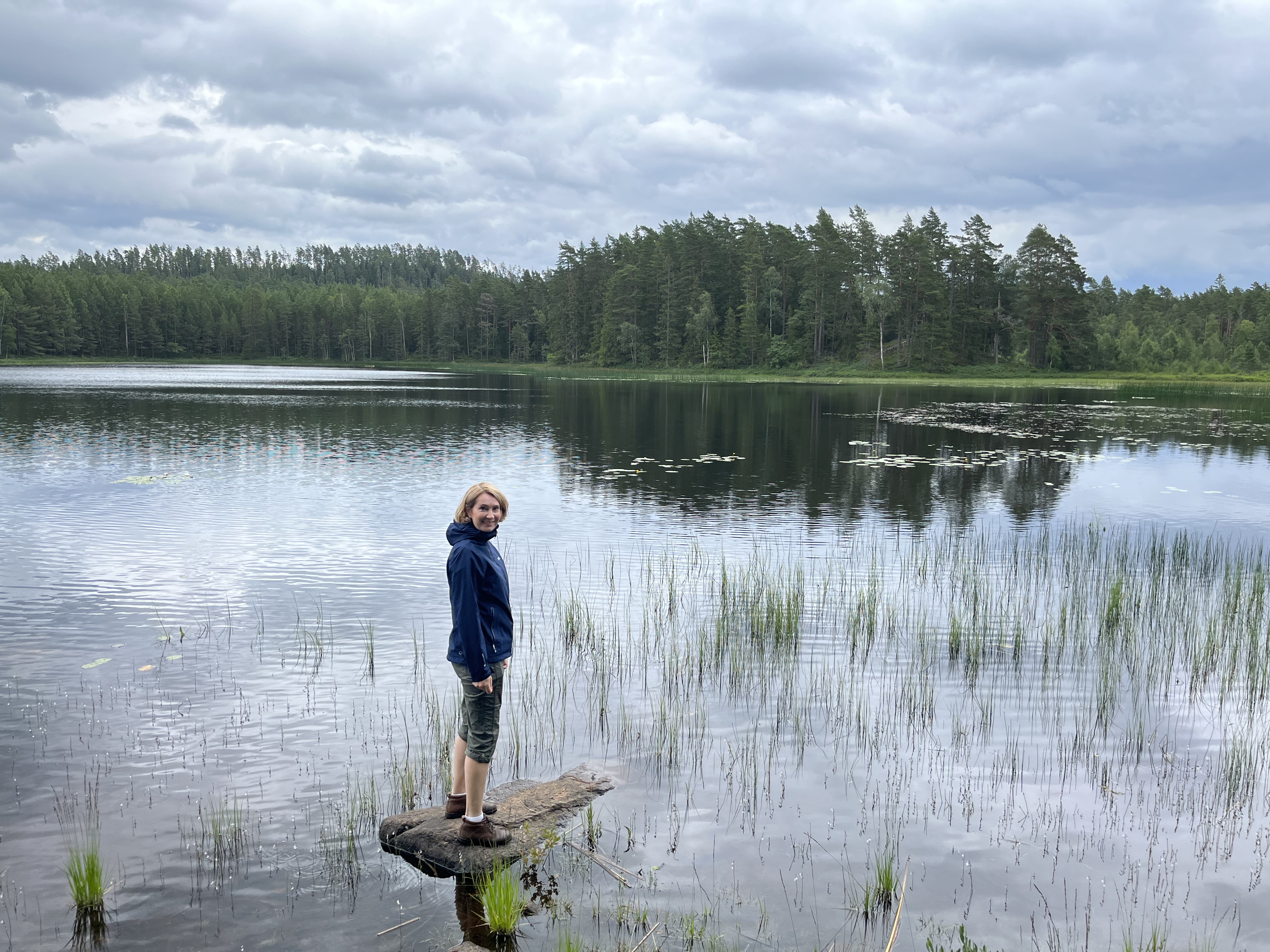
Hi everyone
Those of you that have known me a little while may know that I am currently working on a book about my late father, Alan Carter.
My dad was a larger-than-life figure, who was a role model to me and many others. I’ve decided that this is the year that I need to finish the book, as of course, memories are fading. The people I need to speak to that remember my dad are getting older, and I just need to get this done.
I have a few chapters under my belt already, and they were enjoyable to write. I enjoyed researching about my dad’s grandparents as I didn’t know too much about them. Even my Dad’s own father, he hadn’t told us very much about him growing up, so it was interesting for me to explore why that was the case.
Most helpfully though, my dad had written several detailed accounts of highlights from his childhood and youth. These were invaluable as they were rich in detail and full of mischievous exploits. Having these accounts, plus the input from my dad’s younger brother, Chris, meant that writing about the early part of my dad’s life was effortless, I could let his words do the talking.
The next couple of chapters were ok too, I have my own memories of growing up, so have been able to draw on those. The later chapters I’ve been finding much harder. I left home pretty much at the age of 18 to go travelling and then off to university, so I don’t have the same first-hand lens through which to view everything.
Also, I hit a particular block that lots of biography/memoir writers hit. You can’t cover a person’s whole life chronologically, as it falls into too much repetition. You need those natural story arcs and themes to carry it through. I had an idea of themes to pick up for the second half of my dad’s life, but with an exceptionally busy year last year work-wise I had no mental space left for creativity. So, this is the year.
I have recognized for a long time that I need some professional input to help me with this task. I have looked at various book coaches over the last couple of years, but no-one seemed exactly right. I have now found a book coach that is a good fit. We had our first meeting a week ago (which was amazing) and she gave me some great suggestions to the many questions I had about how to proceed.
And that’s also the reason for this blog. Now that I have a plan, to have the manuscript written by July, and the book published (I’ll be self-publishing) by November, I need to connect with potential readers! If you are someone that will be interested in the book, please hit follow on this blog, as I’ll be using this blog to update progress and announce when it’s ready.
Also – if you were a friend of my dad’s or worked with him, and you have a story or experience to share – please do get in touch, I’m actively looking to fill in some gaps and to paint a picture of the fabulous life that he made along with so many of you.
Best wishes
Rachel
Not long after I had arrived in Eindhoven in the Netherlands, I heard about a place called the High Tech Campus. It sounded cool, a single location with over 260 companies, including start-ups, scale-ups in the tech space, and HQ to some industry giants. It has often been claimed to be the smartest square km in Europe, and possibly the world. It wasn’t too long before I got to go there for a couple of meetings and events. Every time I went it was like meeting a melting pot of internationals. Everyone was open and friendly, and many were from ‘elsewhere’, something that brought a common bond, and English seemed to be the regular language spoken in the events I attended.
Six months ago I started contracting for a company that has its European HQ at the Campus, looking after their Learning & Development function whilst they were recruiting for a permanent replacement. When I started, we were still in work-from-home mode, so it wasn’t until April that I was in at the campus more than a couple of days a week.
Over the last couple of months, I have gotten more familiar with the campus. I now cycle there from home (on my e-bike), a journey of 11 km that takes just around half an hour. My cycle ride takes me into the city-centre and out the other side on the traditionally red cycle paths that line every road. When I get near the campus, my route takes me alongside the river Dommel, green and lush, finally cycling over a bicycle bridge onto the campus itself. It’s hard not to feel energized after such a journey.
One of the campus traditions for my company, and for many it seems, is a lunch-time walk. On my floor, everyone is invited to join the communal walk, regardless of your department, rank or role. We take one of the footpaths and head down to The Strip, which literally is a strip of restaurants and shops which line one of the large lakes that are a feature of the campus, and then circle back, walking over one of the many open footbridges that cross the lake. There are many extra detours available, raised wooden platforms that run through the reeds around the lake, or paths through the wooded areas, with marked routes, handy for ‘walking meetings’ which are easy to do in this setting.
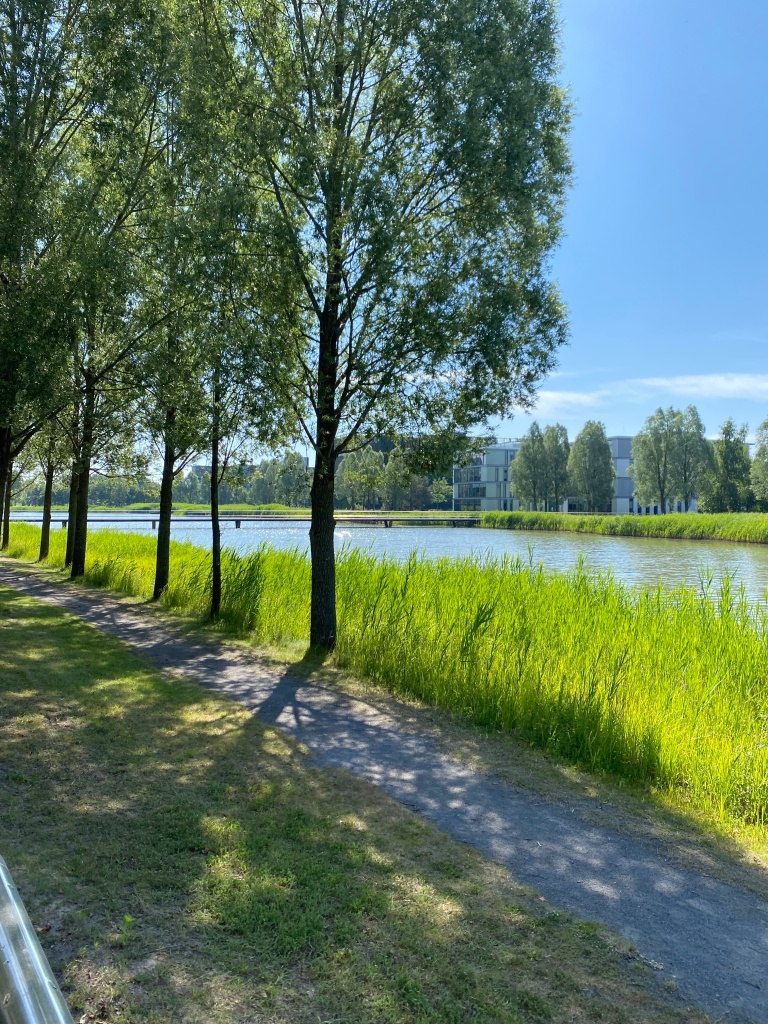
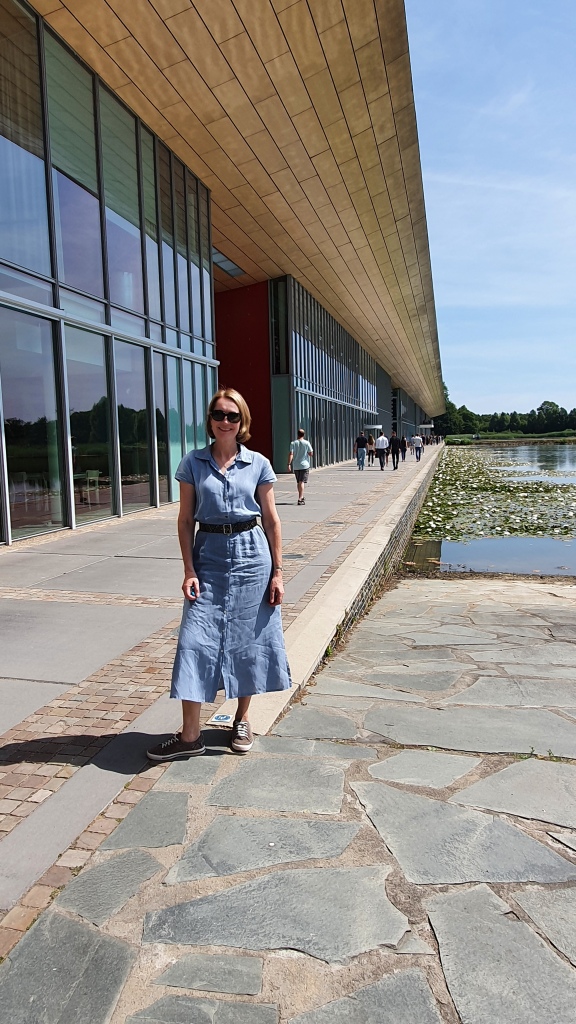
A noticeable difference in working in the Netherlands compared to the UK is the dress code. Jeans, trainers and t-shirts are regular work attire, for men, it seems. The older generation opt for a more professional look with a collared shirt paired with jeans, or maybe chinos to smarten it up a bit. When I was in the UK this more relaxed European style of dressing was considered to be a reflection of a more ‘avant garde’ approach to business, but once you start biking to work you realise that a large part of this style difference comes from practicality.
It has been a nice feeling to get comfortable being at the campus, from those early days observing others wandering round the campus, and attributing them all as smart, techy people, to realizing that I am now one of them. Ok, maybe not so techy, but you know what I mean.
The campus itself is pretty big, so there are campus bikes available that you can jump on to take yourself to the other side if you have a meeting to get to. Even the post is delivered on a post-bike.
I think it’s an amazing place. It has its own sports field, complete with volleyball courts, cricket field, tennis courts and gym. Every Tuesday I join a Boot Camp, with colleagues from Shimano, where a few of us do circuits outside on the field. There’s a creche, and hairdressers. Every year there’s a campus marathon, using the lake.
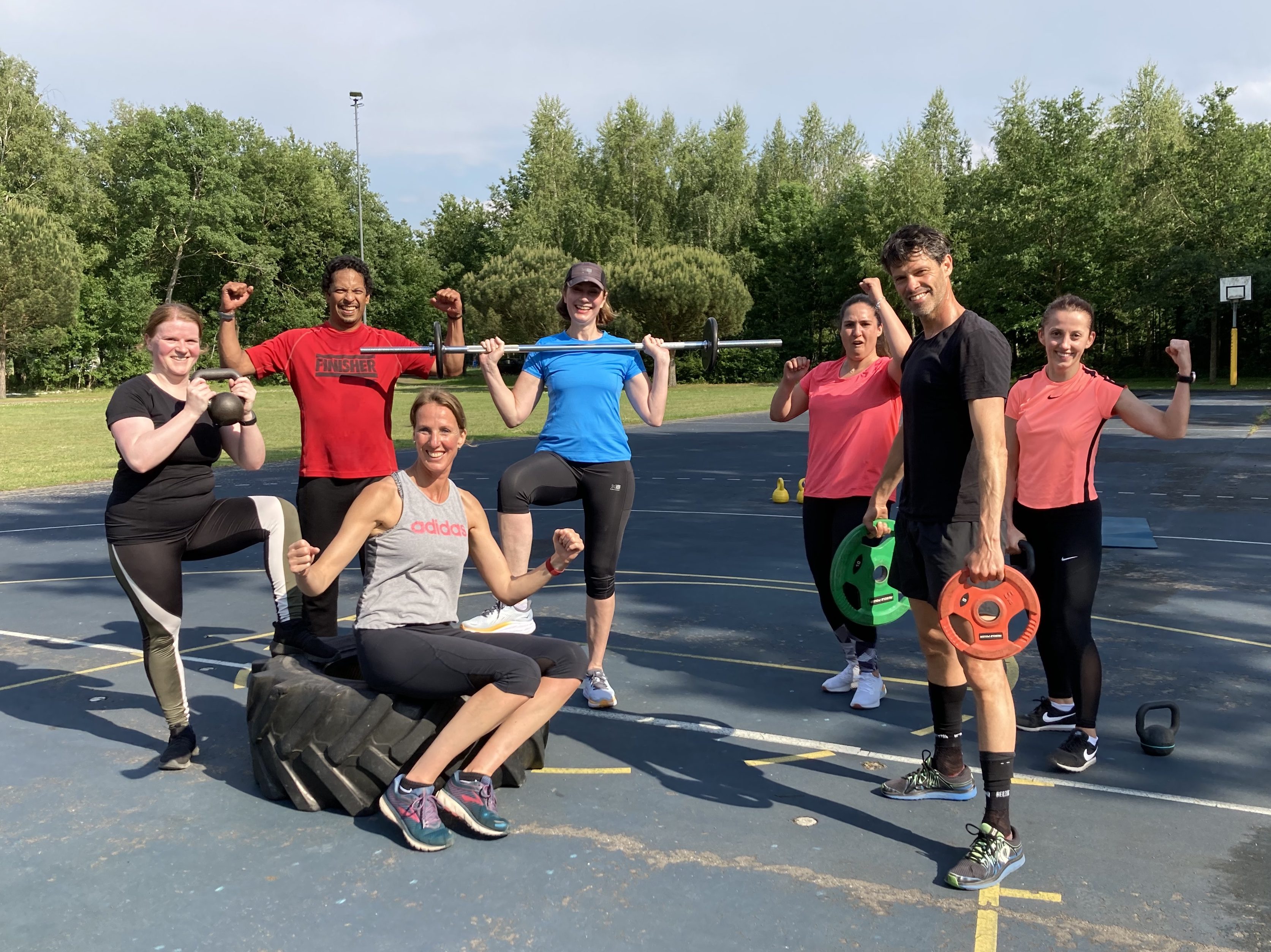
Before I moved here I really had no idea how things would work out for me work-wise, but with the High Tech Campus on my doorstep, I really have nothing to worry about.
I grew up wanting to be an actress. I loved films and theatre. My parents had the vinyl LP’s for West Side Story, and My Fair Lady and I would play them both over and over. I knew every word to every song.
I did lots of acting as a young person. I went to drama classes, took exams and took part in speech festivals. But I wasn’t brave enough to choose to study drama at school, as I always took the ‘sensible’ subjects. I ended up doing a business degree, although part of me would have loved to have studied English Literature with Drama, or some such combination.
Whilst at Uni I ran the Drama Society, so was able to let loose my creative side there. Once graduated and working, I took every opportunity to work with young people, writing scripts and directing short plays. Some of those I was really proud of and won competitions with. Bringing together a group of people and just the right ingredients of a good script, central message, music, dancing, costumes and lighting, and heaps of humour, to create something truly magical, is something I will always relish.
One of the highlights of the last few years for me was attending the Edinburgh Fringe Festival, and having three days of solid performances, some in the street, some in rooms below bars, some in college classrooms. Being sat metres away from a powerful performance of a one-act Tennesse Williams play in the middle of the afternoon is my idea of perfection.
Most of my life I have lived in proximity to London, being able to hop on a train for a day trip or the occasional evening out. Of course, we’re spoilt with the choice of live theatre in the West End. What I loved about living in the UK (and didn’t truly appreciate how unique it was until I moved away), was the abundance of culture. With a family it was not always possible to go and see everything, but to know of it, to hear it talked about on the radio or the tv talk-shows, to hear interviews with the actors, to hear the stories behind the production. That’s what I loved, and that’s what I missed when I came to the Netherlands. Maybe those things happen here, but I don’t know where. I don’t know what channels to listen to or watch, or what to read to find out what’s going on culturally.
Actually, I love Shakespeare so much, I was a bit worried when I came that there would be no Shakespeare here. Shakespeare is one of those tricky things – so much is in the language, the detail, the poetry of the words. That could not possibly work for an audience where English isn’t the first language. Even my husband who is 100% fluent in English and writes academic papers in English, puts the sub-titles on when we are watching certain things – anything where there are accents, or where the speech is so fast he can’t pick out the vernacular.
So, it was from all of this that I set up a Facebook group, English-speaking theatre in the Netherlands. I wanted to find out what was going on and thought that others would too. In Amsterdam they have a couple of the big production musicals every year, which is great, but for me it’s not just about the musicals. Since setting up the group I’ve learnt about theatre groups like STET the English Theatre, in the Hague, and the Orange Theatre Company in Amsterdam that put on high-quality English language theatre.
We’ve topped 200 people in the group this weekend, and I only set the group up over the summer. We’ve had loads of actors join the group too, people that are interested in performing. And it’s been great to find out how many amateur or semi-professional theatre groups there are here for Brits or English-speakers that want to perform. Actually, this is all really important. When you move to a new country, quite often you’re starting over with zero social circle, you have to create a whole new life for yourself. Many things, because of the language barrier, aren’t accessible, so having something for people to get involved with where they can make friends and have good experiences, is invaluable.
I’m a little bit sad that where I live, in Eindhoven, there does not seem to be quite so much going on theatre-wise in English, or even in Dutch actually! I suspect (and it’s tricky to back this up as statistics on expat numbers in cities are a bit sketchy) that as Eindhoven’s expat growth is more recent, then the cultural offerings in English haven’t quite caught up with the demand. I’m hoping with this group in time we can change that!
And of course, it’s important to say, it’s not that I’m not interested in seeing performances in Dutch. I’m still learning the language, and that would be an obvious barrier to understanding a performance, but of course I am open to experiencing what the Dutch have to offer too. I do think that there are opportunities for some creative thinking around making performances accessible where there are language barriers. I saw a production in London called ‘Once’ – a fabulous musical set in Dublin, and when one of the main characters let loose in their native Czech tongue, a small screen at the top of the stage offered the translation in English. Such an ingenious idea. We use sub-titles for viewing films, so why not in the theatre.
In the meantime, I’m enjoying hosting the conversations in the Facebook group. Sharing things (like the British National Theatre ‘live’ performances that are streamed from theatres to your tv screens) with other’s that will appreciate them and getting to know more about what’s going on in places not too far away from me. Building a sense of community with other theatre-lovers, is helping have my cultural ‘fix’ for now.
And if you’re interested in any of the above, we’d love to have you join our FB community here: https://www.facebook.com/groups/englishdutchtheatre
My family has a tradition of a summer family holiday altogether. And when I say my family, I mean my four brothers, two sisters, their families, my mum, and my children. Last year there were around 40 of us. This year we were 25 – the corona regulations making it tricky with the hassle of tests. The risk of quarantines on return meant that some decided not to go.
Our chosen destination was Tuscany. After a year of corona restrictions everyone was looking forward to some summer sun and those rolling Tuscan hills. My brother and his family flew in from the US without too much hassle. My UK family members all flew in. Their holiday was slightly over-shadowed by all the corona test requirements, but they were undaunted none-the-less.
And as for me and my husband? We decided to drive to Italy from the Netherlands. Nearly 1300km, or a 13-hour drive. We stopped off for a couple of nights on the outward journey, taking in the Black Forest in Germany, and Lake Maggiore in northern Italy. For our route back we stopped off in the Cote d’Azur, South France, and a final stop-over in Dijon. In total we passed through seven countries (if you count Monaco) – and we didn’t have to take a single test, show our ID, or our vaccination pass once at a border. In fact, the only time we had to show our vaccination pass was to get into a couple of museums in France.
Isola Bella, Stresa
The Scharzwald in Germany was stunning, fir trees on mountainous hills, with the winter ski runs visible and sapphire-coloured lakes in the middle. However, it was our stop at a lake in northern Italy that had the hidden surprise. When booking things online for a road trip one looks at the route rather than things to do on the way, and all we knew is we’d booked an Airbnb on the edge of a lake. To get there we chose the scenic road, hugging the edge of Lake Maggiore from the north, driving to our destination on the south shore. The lake was stunningly huge, and a feast for the eyes after a few hours of motorway driving. We stopped to take in the views properly, and the faded Italian villas dotting the lakes perimeter suggested a time more glorious.
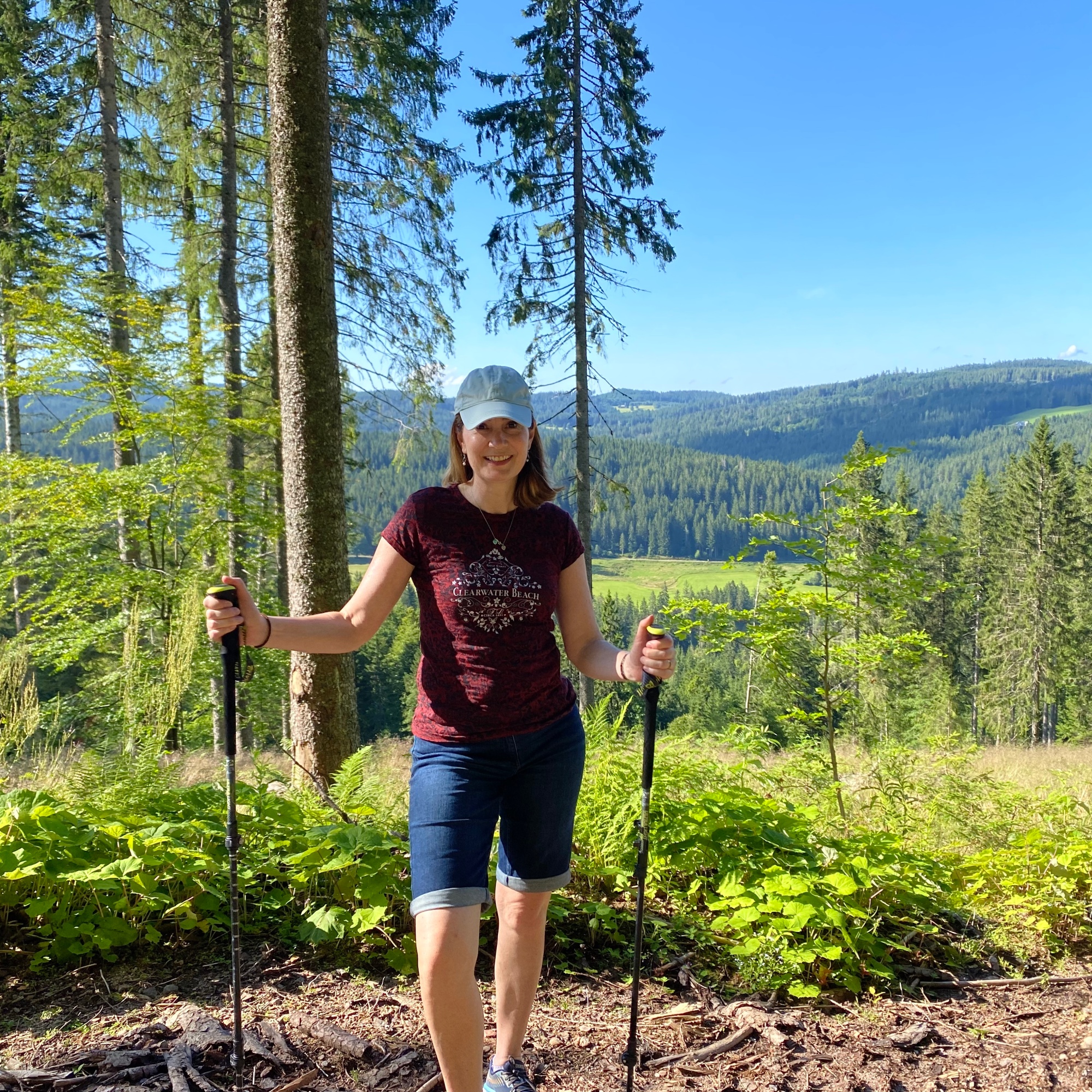
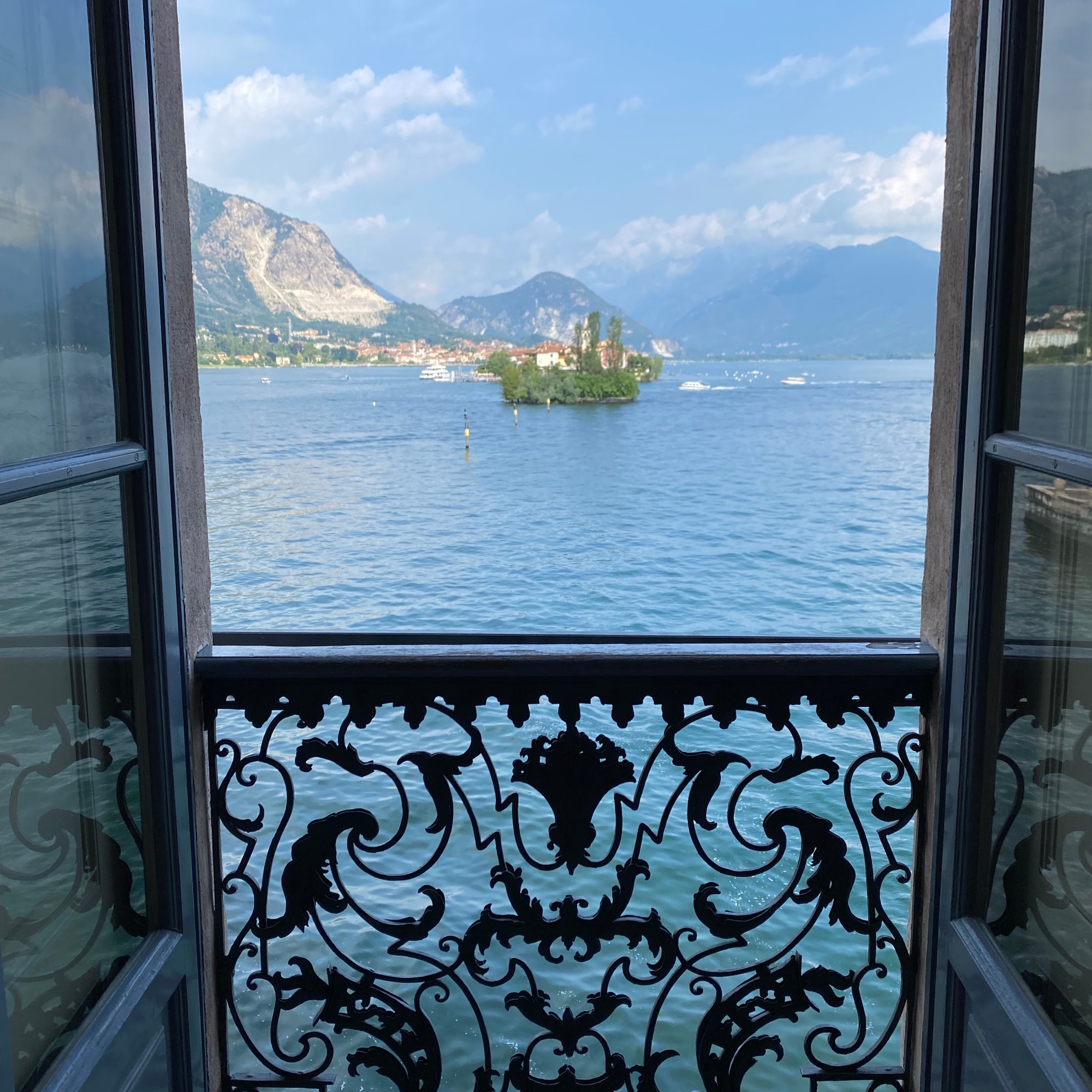
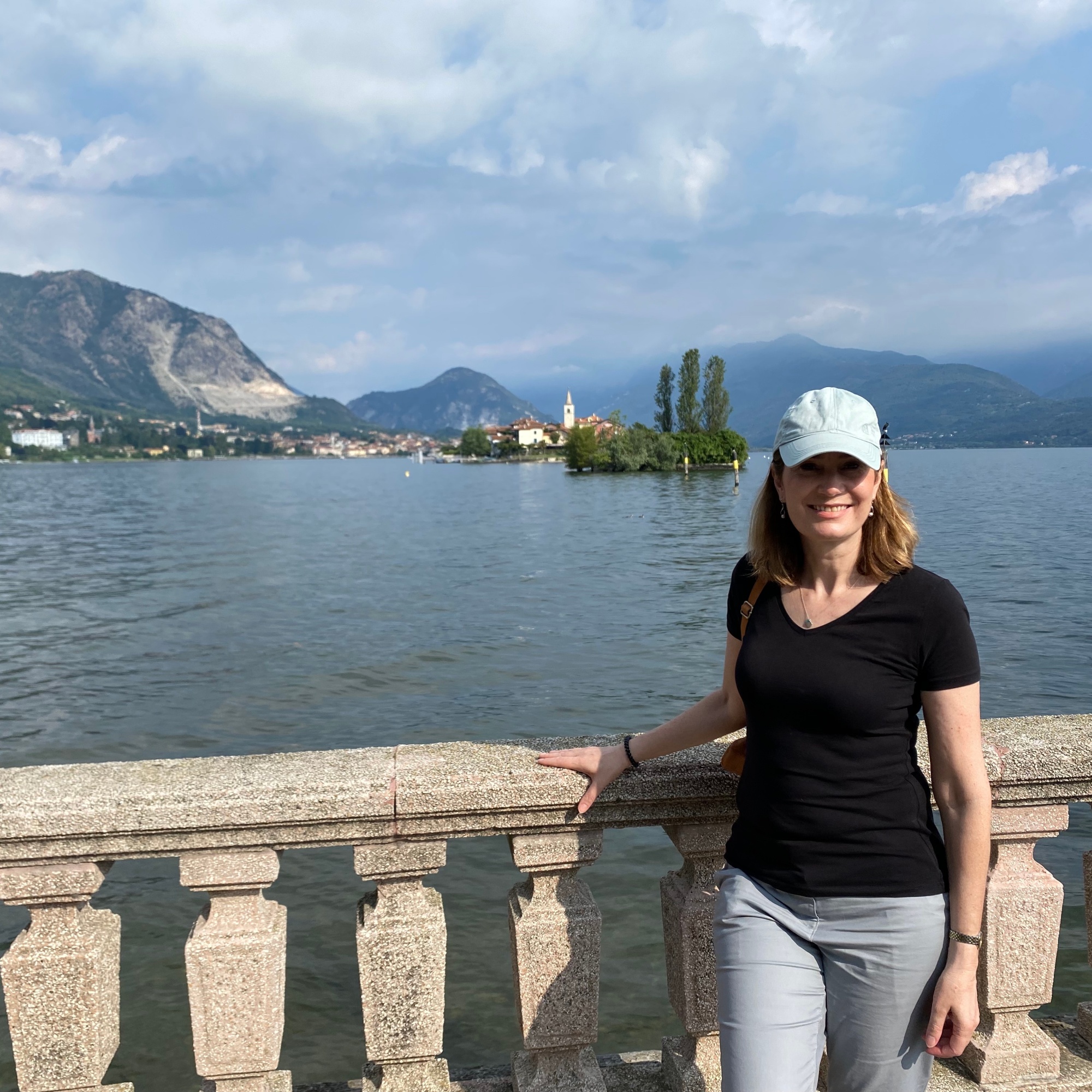
As we reached Stresa, we passed towering white Art Nouveau hotels lining the promenade along the lake’s edge. Narrow streets punctuated with pretty piazzas wound through the ochre-coloured storied buildings. It was in exactly one of these that we were to be staying for the night, and our host was keen to recommend places for us to visit. Our original plan had been to get up early and drive to Milan before heading to Tuscany but landing ourselves in such a jewel of a place we felt we should honour it. Early the next morning we took the ferry to Isola Bella, the island palace, a short ride away. There were three islands in total.
The grand palace literally consumed the whole island, which consisted either of gardens, or walkways wrapping the palace itself. On the stone walkways street vendors and ice-cream stalls had laid out their colourful wares. The palace itself was opulent, rooms crammed with tapestries and paintings, floor to ceiling, most of which had been commissioned for the palace and created by teams of dedicated artists. Views across the lake were framed by fabulous windows. The last section of the palace held a grotto created to be like an underground seascape. The 10-storied palace gardens had white peacocks strutting around, everything was lavish but miniature, an over-the-top fountain resplendent with statues as the centrepiece.
After our visit, we were back in the car, for the final leg of our journey to Tuscany. I drove this bit, along the coastal route – which consisted of more tunnels than I care to remember.
Tuscany
We finally pulled into the villa at dusk, to be greeted by my family. We had lucked out, and our designated apartment in the two-villa complex had a balcony view, as wide as you could see, with rolling Tuscan hills, and just as I was taking it in for the first time, there was a glorious sunset unfolding.
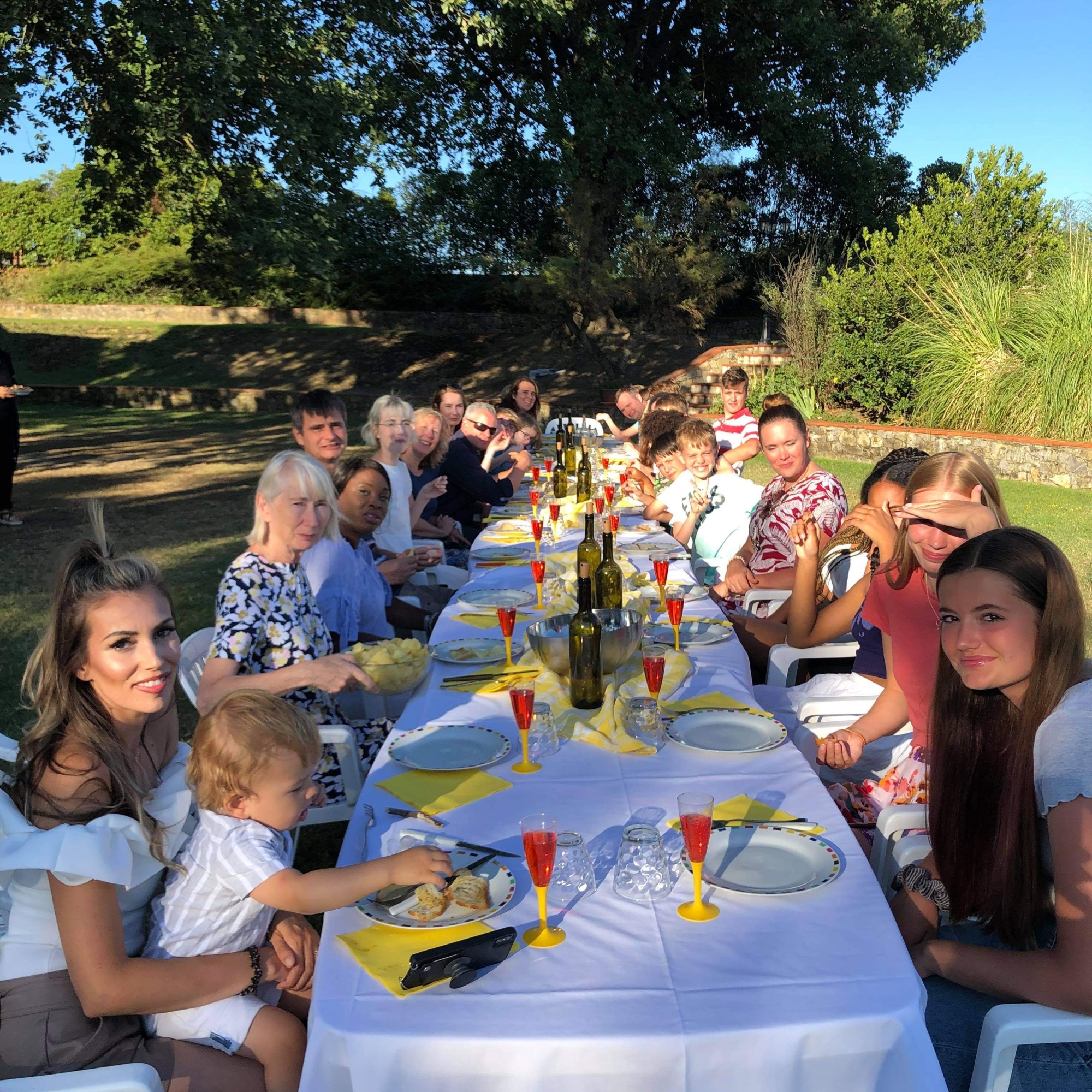
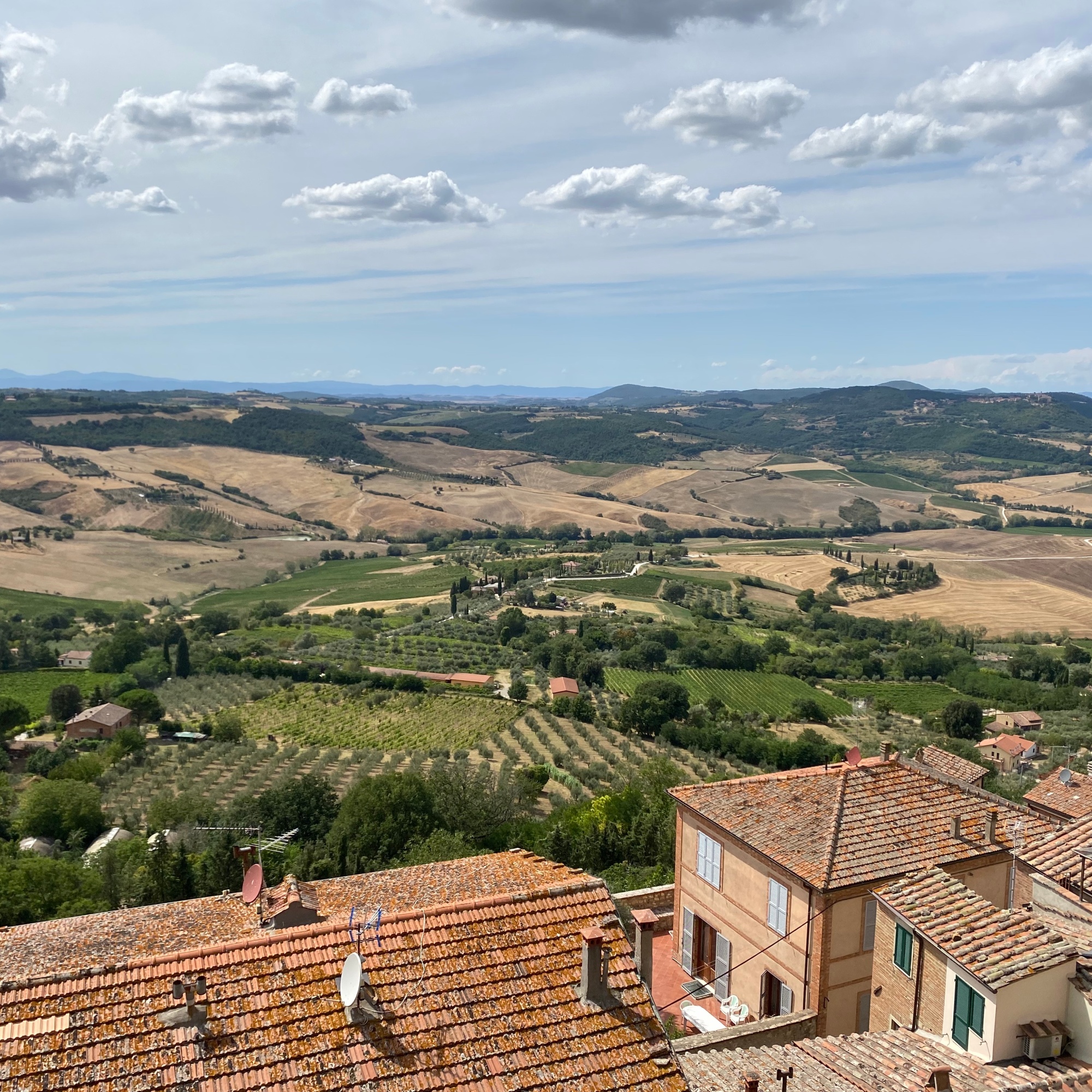
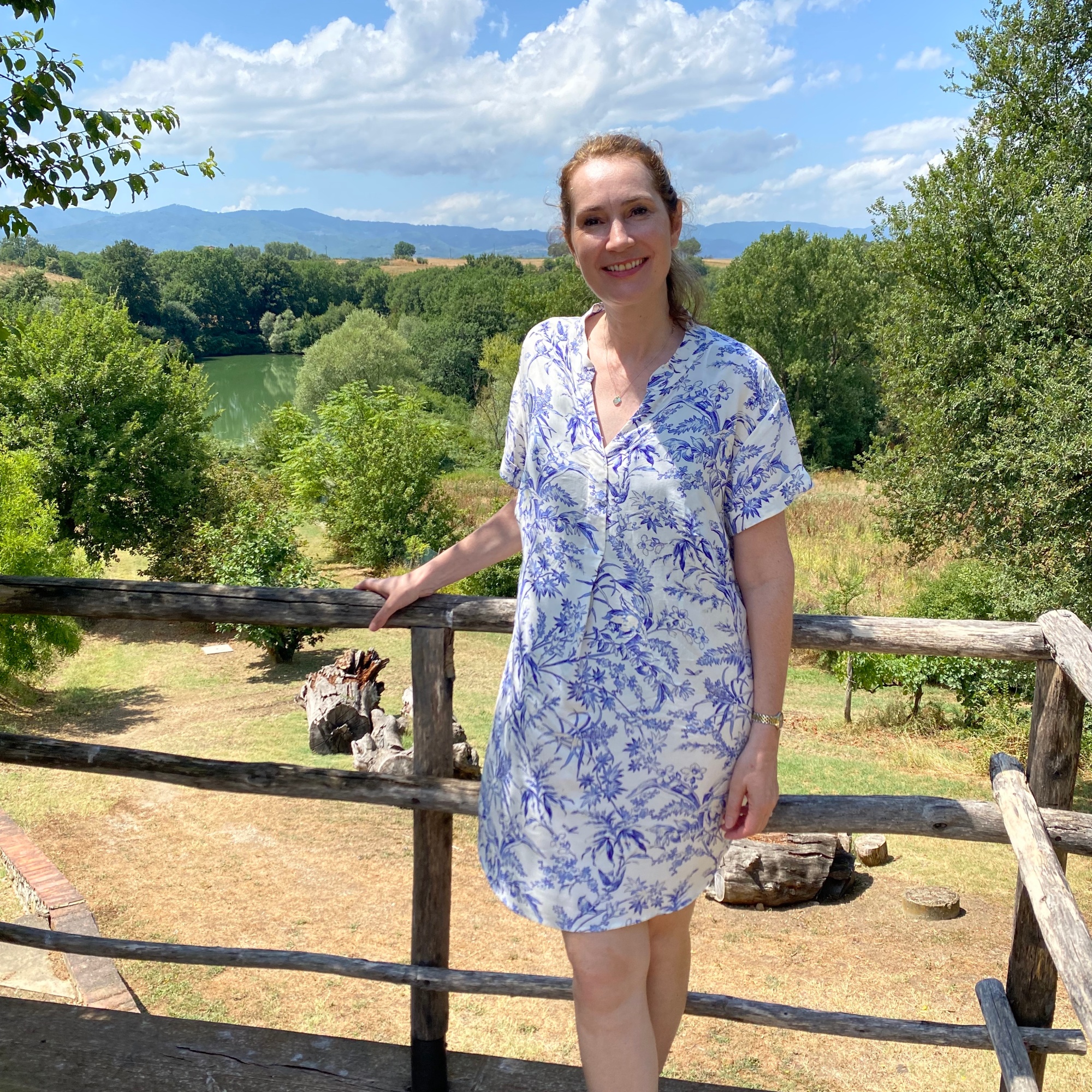
The next few days were spent catching up with family, swimming in the pool, and exploring nearby towns of Sienna, Arezzo, Montepulciano, and a trip to Florence. The highlight of this week was not just one but two dinners al fresco. Our Italian hosts cooked a special Tuscan banquet for us. We sat on long trestle tables with white cloths, with a view over the hills to one side, a vineyard on the other, jumping up to take pictures when we were bathed in the glorious evening light. The many courses meant that conversation could flow unchecked, and when it was dark, we played music and danced under the stars with the children to whom bedtimes had become non-existent.
Our last day a bunch of us went quad biking, a nice adrenalin thrill after a few days of gentle tourist walks. Motoring through hill-top villages and off-roading alongside rivers on bumpy paths for 3 hours was a good challenge for us all.
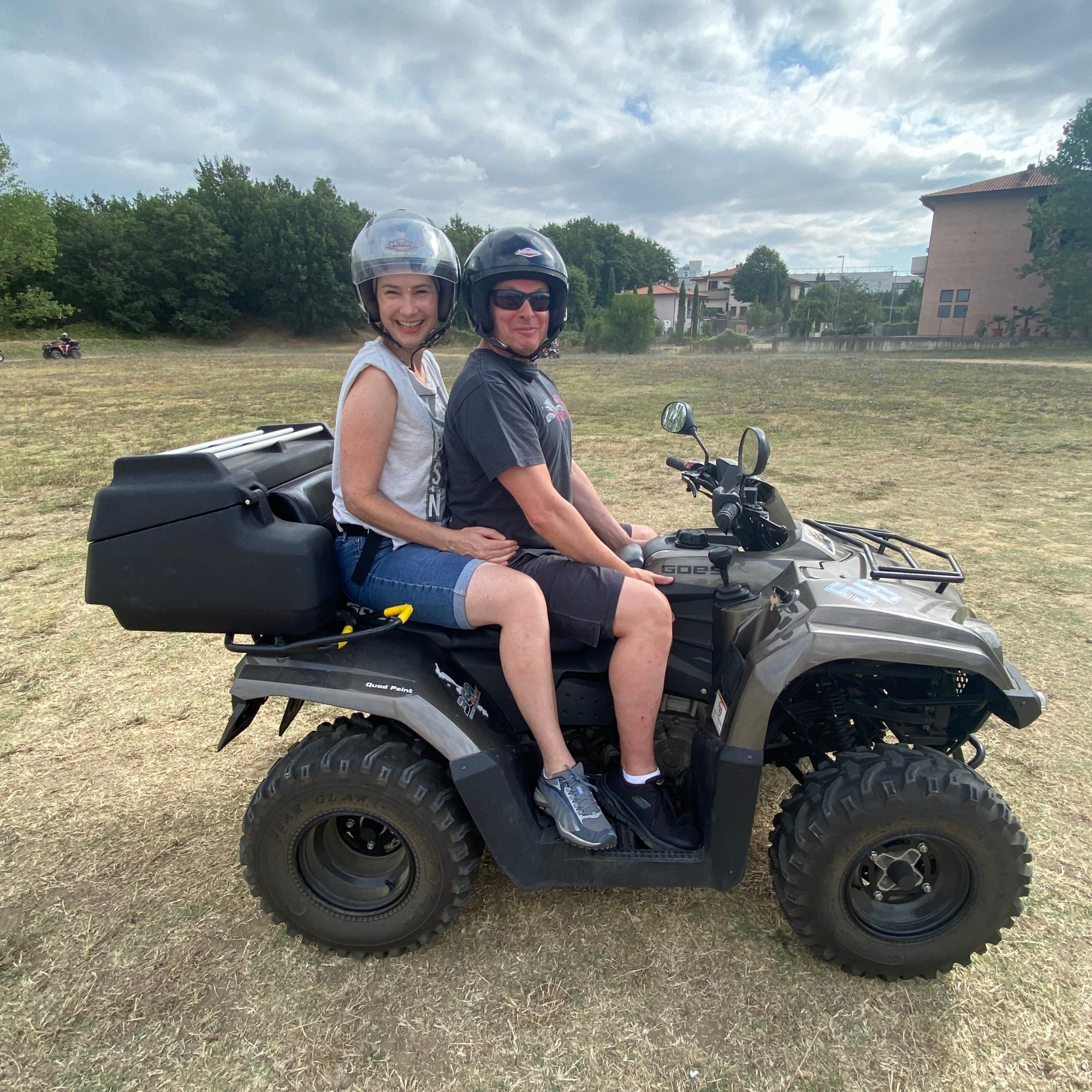
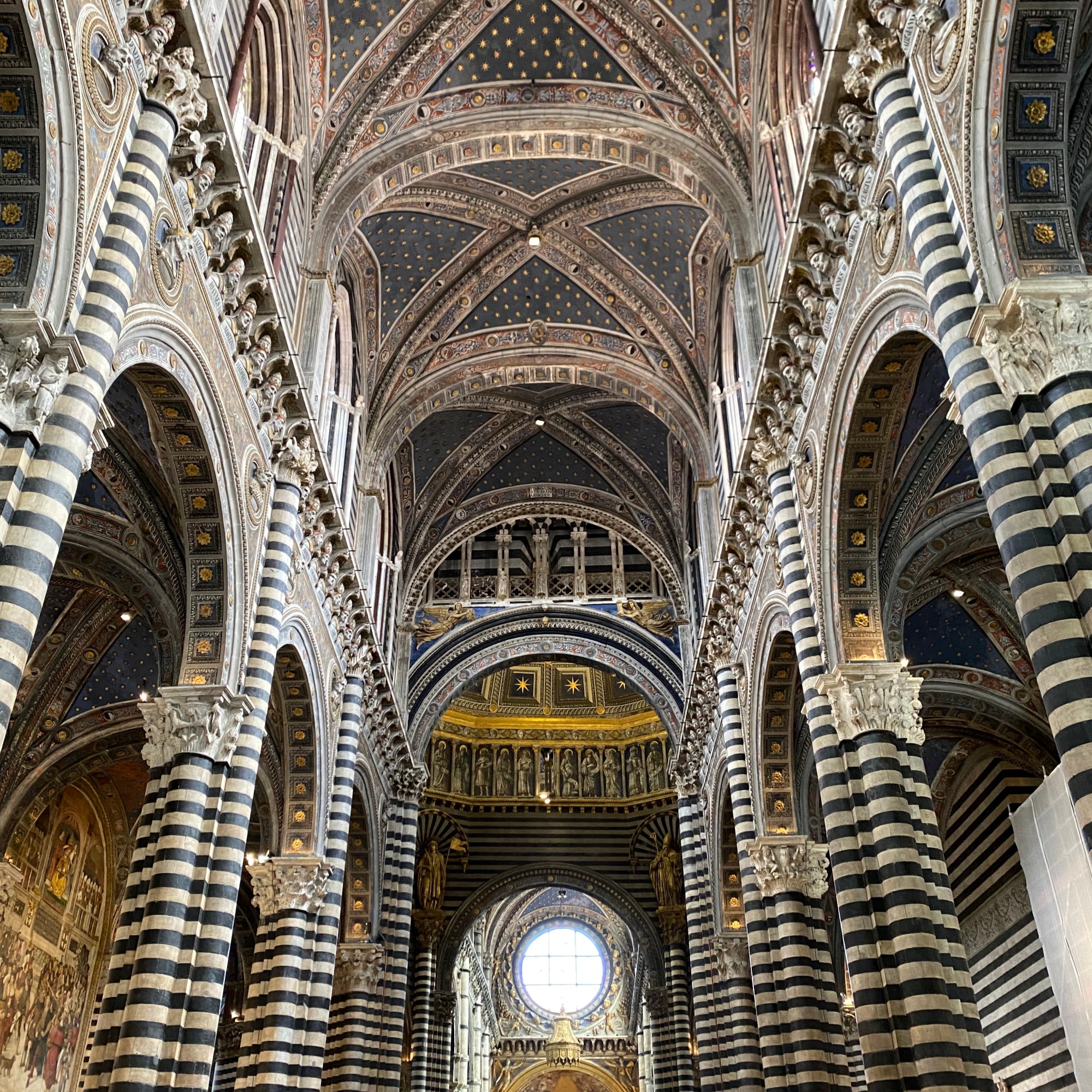
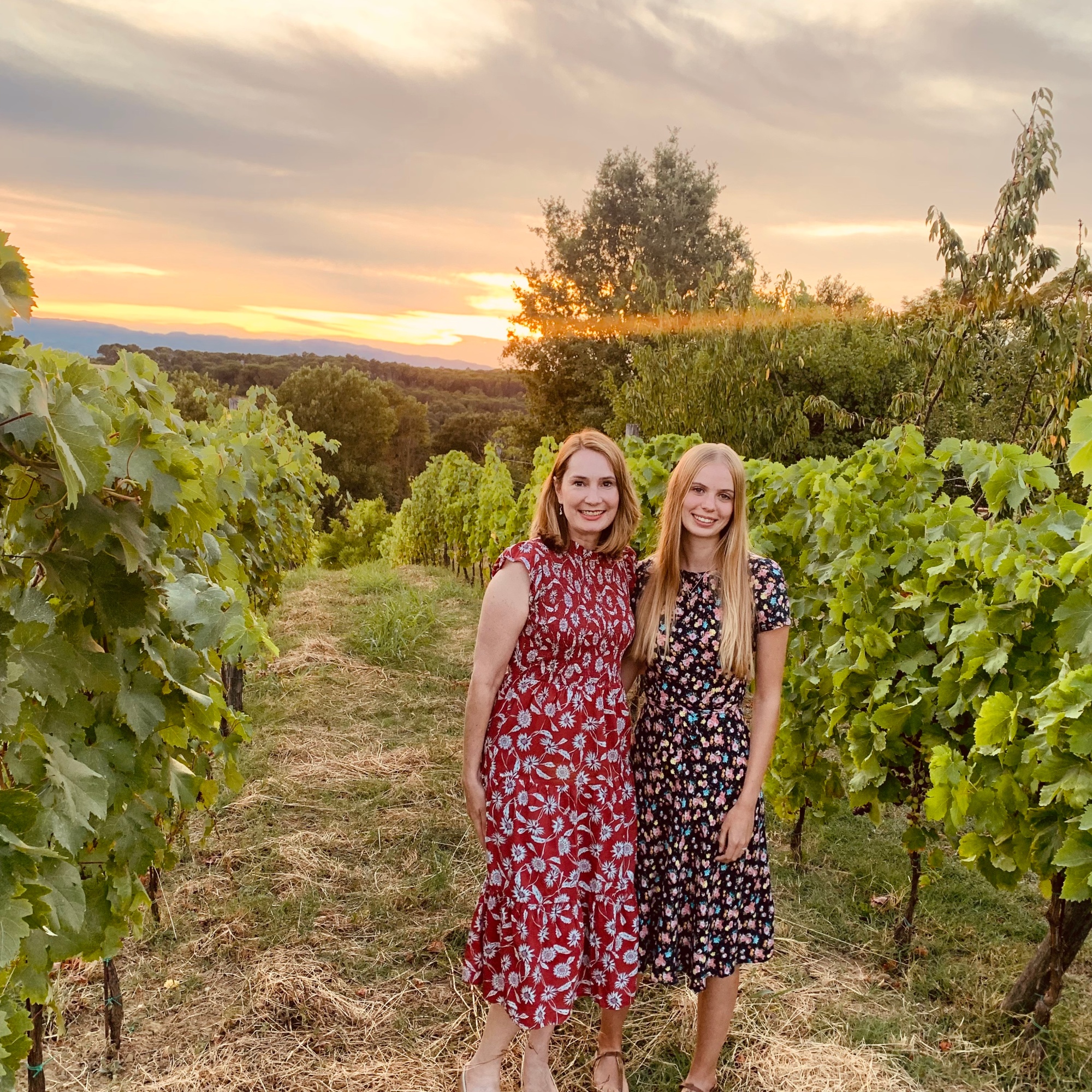
Our last day in Tuscany my husband and I set off early for our next stop. We headed up the coast to France, stopping for a wander in Monaco, taking in the famous square in Monte Carlo and enjoying a walk around the harbour where we ogled billionaire’s boats. (Seriously, a yacht with its own helicopter?).
The Cote d’Azur
Our destination was Villefranche-sur-Mer, a small resort nestled between Nice and Cannes. That evening we walked to the beach down many steps. It was swelteringly hot (as it had been all week) and we were desperate to swim in the sea. The pebble-beach was packed, but the best respite was in the water, which was warm.
The next day we took a bus into Nice, our first port of call being the museum. I was delighted by the exhibition running, L’Amazones du Pop – all about the women in the pop art movement.
Next, we hit the beach. There was a strong breeze, creating a heavy surf, and with the beach’s natural formation of a steep incline at the shoreline meant getting into the sea whilst walking on hot stones was somewhat tricky. Once in, bouncing in the waves was fun, but getting out was equally challenging. When we’d had enough of the wind and intense sun on the beach, we wandered through the town. The small streets bustled; this was the busiest place we’d seen all summer so far. Nice Centreville was very appealing, bright colours, shops, restaurants with terraces.
I had a flash back to my last trip to Nice, 32 years ago, whilst backpacking around France by train with my friend Cathy. That was a trip on a budget, full of simple pleasures, taken in our student days. There were no mobile phones or instant bank debit cards. Just us, our backpacks, a budget in francs, and Walkman’s with two cassettes between us. Those were days when a plain baguette, slice of gruyere and a bottle of Evian whilst sat on a jetty in the sunshine made us feel rich.
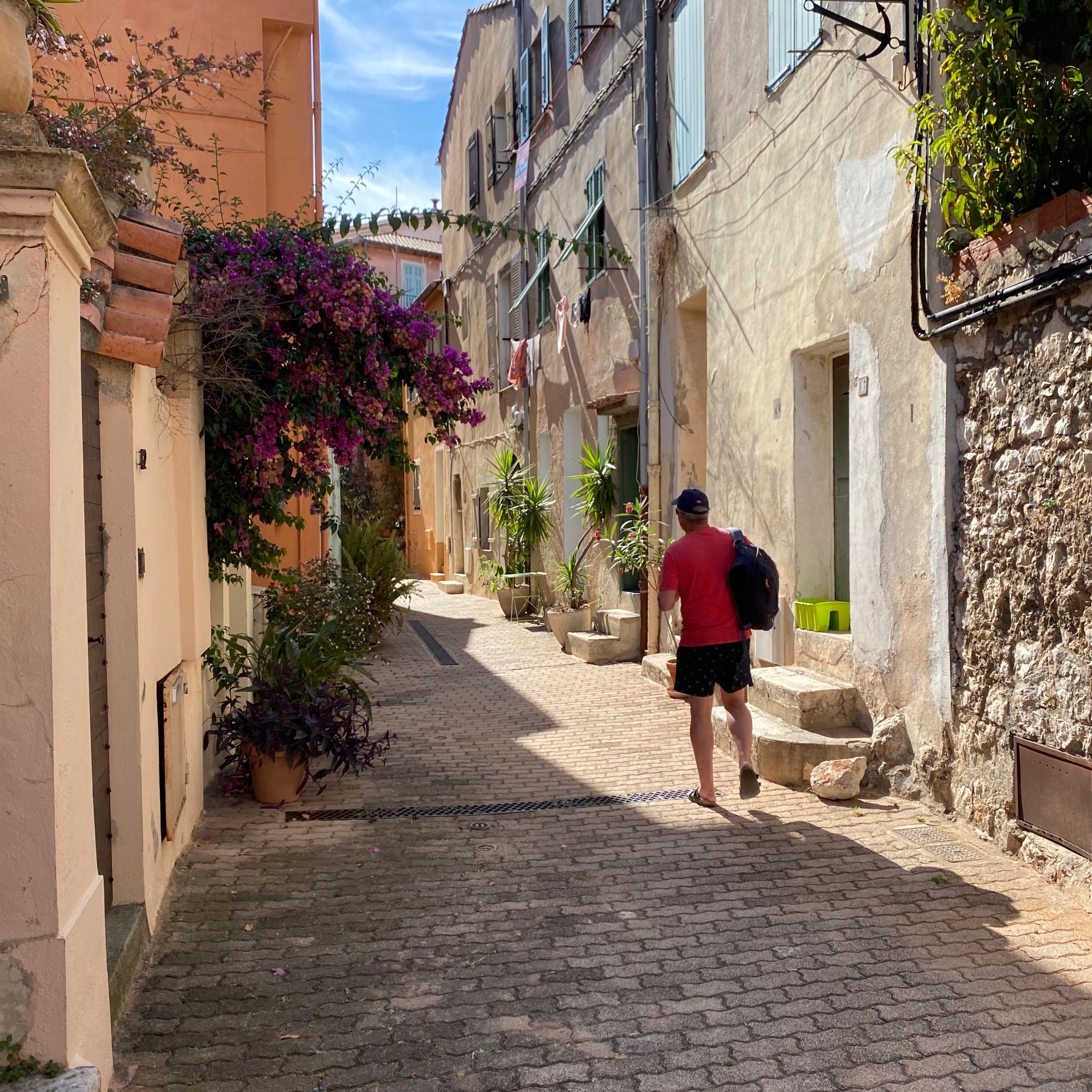
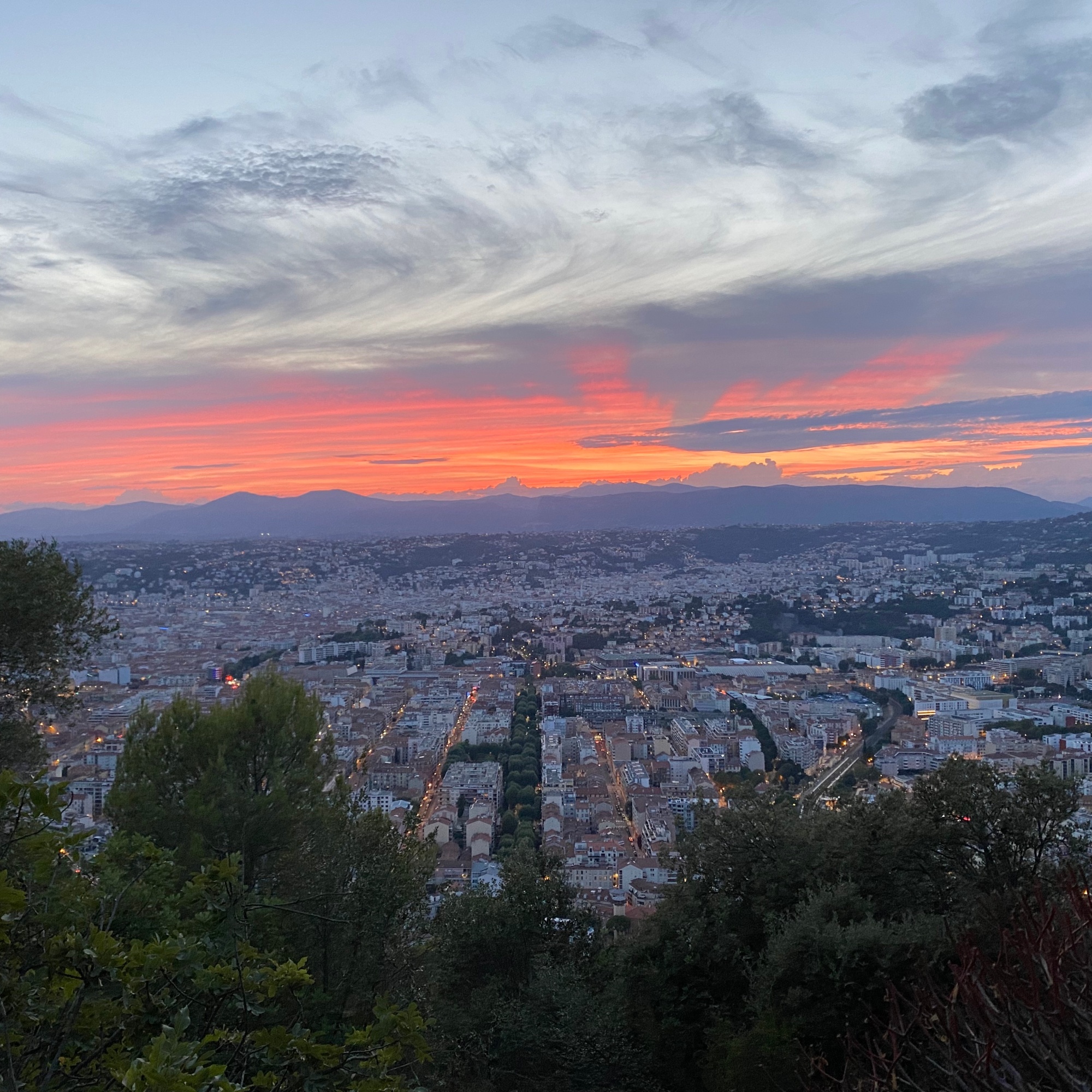
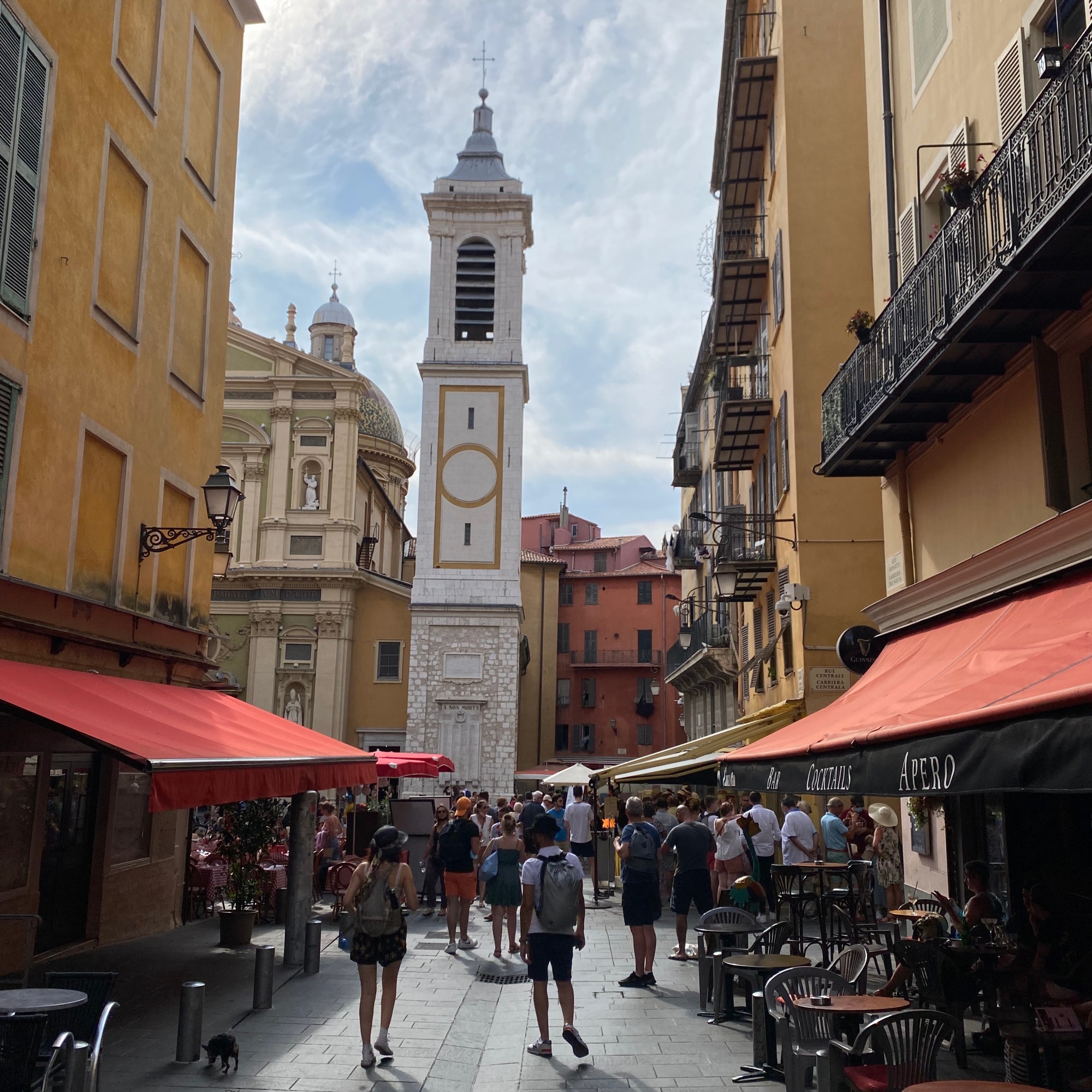
Dijon
After Nice we were pointed for home, driving north through France. This was the route de Soleil in reverse, and we were grateful for the quiet motorway as we sped homeward. Our final stopover midway was in Dijon, again chosen for its location rather than anything else. We wandered into the city before heading to our Airbnb, and a visit to the museum. Dijon, home of the Dukes of Burgundy who had once ruled north-west Europe. And the home of mustard, of course.
A lovely surprise at the end of our trip was our wonderful hosts for the last night of our adventure. This French couple opened their home as if we were not just guests, but friends. They cooked for us in the evening, and we all ate together in their large garden, ‘parlant francais’, trying anyway. It was a delightful encounter and repeated in the morning at ‘petit dejeuner’, fresh croissants from the patisserie accompanied by our basic Franglais. The night before, on discovering my husband played the piano, they invited him to play for them. There we were, sat in a beautiful living room with antiques and modern art, Valentin banging out Bohemian Rhapsody and Billy Joel’s Piano Man, with our hosts both dancing and filming him at the same time!
The rest of the drive home was uneventful, France, Luxembourg, then Belgium and finally the Netherlands. Home is always good but travelling awakens the soul and creates memories to store up for the dark winter days ahead.
My most repeated phrase of the last 18 months since living in the Netherlands, often felt like an apology rather than a statement to indicate my Dutch language skills were not quite up to the mark.
Despite my best intentions, learning a language during a pandemic is not easy. Various levels of lockdown, shops and amenities being closed, visits with other people disallowed – all these factors do not help to immerse oneself into a new culture.
My weekly language classes I had started at my son’s school were cancelled in the first lockdown and never reinstated. My son home-schooled for a large chunk of the last year and this, which changed the priorities at home, with well-being and outside exercise to break the day up becoming the priority, not more learning.
I tried an online class, which was good, and I made progress, but these were only available in the evenings, and after busy days running my business (which is entirely online and with UK clients) I found it hard to take it all in.
Frustrating too were the mouth-masks, or ‘mond-kapjes’ in Dutch. Any attempts at conversing in Dutch with shop-assistants through layers of masks and screens went awry. One trip to the orthodontist to discuss a sensitive matter around health insurance was a complete failure when she could not hear/understand me, and I had to go home and get my husband to telephone instead.
I tried to teach myself. I have text-books, story books, apps, audio-books and podcasts. I’ve tried them all. Teaching yourself isn’t easy. On my own I struggle to structure the learning and with no-one to be accountable to other than myself, I drift.
As I’m just a little over 18 months here, I feel I need a system that will work for me. I decided learning for me must be one on one, with a teacher to meet me at my level, giving me nowhere to hide.
I’ve set something up with family members. I speak to a sister-in-law two evenings a week for half an hour (or mostly she speaks to me). She lives in the US and is happy to get to speak Dutch. She’s great as she speaks slowly so I can follow and make out the words. And I can mostly get the gist of what she’s saying. Anytime there’s a word I don’t know she types it into the chat and I make a note of it. So, my vocabulary of ‘regular’ conversational words is growing. I’ve been floundering in putting sentences together in response, so I’ve asked another sister-in-law, trained as a primary school teacher, to help me out with some more structured sessions. So now two mornings a week, at 9am, we work through basic grammar.
From my arrival here to now I feel like I have forgotten more than I have learnt. I feel like I’m going round and round and not moving forwards. But learning a language is one of those things where there is no quick fix. There is no learning ‘hack’ that can take the place of hours of study and practice. Last year I read a lot of books about learning, how the brain takes in information, sorts it and recalls it. My ‘day-job’ for many years has been corporate learning & development. Knowing how learning works does not necessarily make learning easier. But I am aware that I will need structure and a system to learn, and then lots of repetition, and practice at recall. I’m also aware of the importance of ‘mindset’. Thinking that I can’t do it, being afraid to try, not wanting to look stupid and make mistakes – these are all self-limiting beliefs. I am fortunate enough to have people around me where I feel safe enough to try out my learning. It may just take me a little longer.
And in the meantime, I’ll have to keep saying, ‘Sorry, I’m English’.
Every country has its calendar of celebrations, as well as its own customs to mark birthdays and other life events. The Dutch are no different. Having been here for over a full-year I have witnessed the full calendar cycle, as well as birthdays, weddings and other celebrations. Here’s my take on the Dutch-style of celebrating.
New babies
The Dutch have some lovely traditions to celebrate the arrival of a new baby. One time I was in a jewellery shop being served and the owner presented me with a small plate with a large round thick cracker, covered with blue sprinkles. I had no idea what was going on, until my husband said that their colleague had just had a child, and this was the tradition. It’s called beschuit met muisjes (biscuit with mice), and has pink or blue sprinkles depending on, well you can guess. These are served to the first visitors when a new baby is born. On our walks round our neighbourhood, sometimes there are large signs in the front gardens of houses, or in the windows, announcing the birth of a new baby. Usually the name, and maybe a picture of a stork, make up the display.


Birthdays
This signage continues for regular birthdays. The Dutch have no issue with having big banners in front of their houses, announcing the birthday of the inhabitant. Last year my husband turned 50, and I discovered just in time the tradition that when you turn 50 you’re said to have met ‘Abraham’ if you’re a man, or ‘Sarah’ if you’re a woman. This is based on the Biblical reference John 8: 56-57. So, it’s not uncommon to see a giant inflatable cartoon style Abraham in someone’s garden. I was a little nervous about going all out for my husband’s birthday, having not actually seen anything similar at that point, so I opted to play safe and just make a banner. I enlisted the help of two of my new nieces, we wrote a little poem, and surprised my husband on his big day. It brought a few congratulations and smiles from neighbours and passers-by. It said: ‘je kunt het niet aan hem zien maar onze Valentin is vandaag vijf x tien’.

When it comes to regular birthdays, I had been very confused by the limited amount of birthday cards in the shops. Apparently, the Dutch don’t give birthday cards generally, only when they’re not actually going to see the birthday boy or girl. So, turning up at a party with a gift but no card is just fine. I was equally flummoxed when Valentine’s Day rolled around. I’m used to this being a full-on commercial event with the shops reminding us weeks before with arrays of pink and red gifts stocked on shelves every time you go to the supermarket. Valentine’s Day isn’t such a big deal here, and I even struggled to find a card in a card-shop.
Weddings
It was a huge surprise to me that the Dutch cannot get married in Church. It is purely a legal contract, and is done at a town hall, by a civic representative. There can be no hymns or prayers said. Of course, there are hotels and other venues you can pay to host your wedding, just not in a Church. A lot of people, however, opt to have a church blessing after their civic ceremony. That said, my sister-in-law’s wedding (trouwerij) last December was a wonderful affair, with words spoken by the ‘trouwambtenaar’ (marriage officer) and talks from chosen family and friends.
Kings Day, Liberation Day & Carnaval
Of course, the Dutch have celebrations we don’t have. Kings Day (Koningsdag) is a big thing, which sadly was cancelled last year and this due to the Corona outbreak, although I was here for a visit the year before so caught glimpses of everyone in their orange costumes, and I look forward to when I can experience the ‘vrijmarkt’ or ‘pavement sales’ that take place, where anyone can sell anything (books, games usually) on the pavement in front of their houses, a bit like a giant communal garage sale.
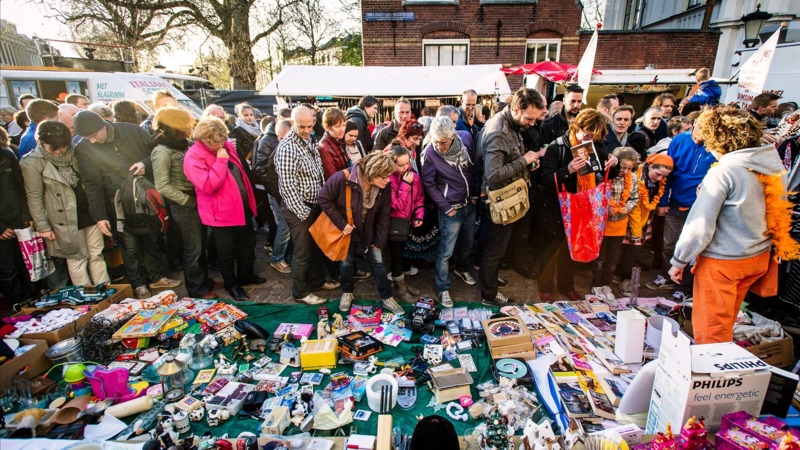
Flags are a big thing, and most houses have a flag-pole. Flags are hung on Kings Day and Liberation Day (Bevrijdingsdag). The flag-poles are also used for graduation – a student finishing school hangs his books and school bag on the pole or out of a window to signify that they have finished.
The Dutch remember all who have died in war situations since the 2nd World War on Memorial Day (Dodenherdenking) which is commemorated on the 4th May – with 2 minutes silence at 8pm in the evening. The 5th May is Liberation Day for the whole of the Netherlands, to celebrate the end of the German occupation. These days aren’t bank holidays but flags will fly and schools will teach about it. Military parades with veterans will take place. In the south of Netherlands, where we live, a sort of Liberation Day is celebrated in September as that’s when the southern part of the Netherlands was liberated during Market Garden. I was lucky enough to be here in 2019 for the 75th anniversary celebrations and saw an array of tanks and other military vehicles descend on the City in an impressive parade. There were many veterans taking part and the whole experience was very moving. To see all the people out in the streets, paying their respects to those that liberated them from Nazi occupation.
Carnaval takes place 40 days before Easter, and originated from a Catholic feast dating back to the Middle Ages, when fasting began before Easter, much like the British pancake day. That is where the similarity begins and ends, however. Carnaval has become an all-out party, where people dress up, drink beer and sing silly songs, like ‘er staat en paard in de gang’ (there’s a horse in the hallway). This goes on for a long weekend, and the fancy dress shops are busy providing people with different outfits for a weekend of partying. Carnaval is only celebrated ‘under the rivers’ in the south, as the Protestant north frown upon such festivities (although people travel down to join in the fun – which is what led to the Netherlands first spread in corona transmissions last year).

Christmas versus Sinterklaas
Christmas is a bit different, and again not such a big thing here. Presents are traditionally given on Sinterklaas, which is on the 5th December, and Sinterklaas is like a Father Christmas equivalent, arriving instead by boat from Spain with his helper, Zwarte Piet. The Dutch refer to what us Brit’s know as Boxing Day as ‘Second’ Christmas Day, but, unlike the British, they don’t get the bank holidays carried over if these days fall on the weekend. This is a travesty in my opinion!
Whereas Christmas in the UK is characterized by turkey and trimmings, there is no set meal here. Of course, I have introduced my traditional Christmas dinner into our Dutch life, although we nearly ran into difficulty my first Christmas here when the turkey we’d pre-ordered didn’t materialize. Clearly something was lost, not just in translation, but in custom – when the Turkish wholesale butchers we’d ordered it from, offered us two chickens instead, or suggested we come back the next day (which was Christmas Day). This was nearly the scene of my first ‘new-country culture shock’ meltdown. I’m sure a semi-hysterical woman having a rant in English did nothing to help proceedings. We drove to a regular butchers’ shop who had one last (enormous) turkey in the window which we promptly purchased and our Christmas was saved.
